1928 Article: The Grand Yachts of the 1920's
https://abrushwithsail.blogspot.it/2012/06/grand-yachts-of-1920s.html
The Grand Yachts of the 1920's
Adapted from 'The Major Yachts' by Bennett Fisher.
Published in ‘Sailing Craft’ in 1928
The New York Yacht Club , founded in 1844, is the oldest American yachting organization and it has always maintained it’s present position as the most important single club in the country.
It is natural therefore that the finest yachts on the coast had almost invariably been in its fleet and had taken part in its Cruise. So great is the reputation of this Club that the winners in its races have been looked upon as the outstanding boats in their respective classes. Other clubs however, notably the Eastern, hold important regattas for the big boats each season, but the entrants are practically the same.
During World War I there was no Annual Cruise and it was predicted that the day of the large yacht was passing. This has not been proved the case because the cruises of recent years have been very successful. The change has been in the spirit of the sport and now cruising qualities receive greater attention and schooners take precedence over sloops. The fleet that goes east now is composed chiefly of wholesome two-stickers that require comparatively small crews. Refinements in sail plan have made possible this advance and there is little doubt that the modern staysail schooner is faster than the full-rigged cutter of fifteen years ago with her clumsy club topsail and complicated gear.

When racing was resumed after the War the fleet was small but the schooners were of the first rank and well handled, the most conspicuous being the VAGRANT , owned by Harold S. Vanderbilt, Commodore of the club from 1922 to 1924. He sailed her almost faultlessly and was successful in winning both the Astor and King’s Cups two years, an achievement that has never been equalled. Almost a sister ship this 109 foot Herreshoff schooner is Carll Tucker’s Ohonkara, which took part in a number of races. The Marriette of Boston completes a trio of combined racing and cruising yachts that would be hard to improve upon for accommodations and seaworthy qualities. Besides these there were the big Sonnica, Princess, Irolita and others.
The short high-sided Queen Mab played an important part in the squadron runs, because her low rating of 46 gave her a liberal handicap and she never lacked competent handling. Her owner, Nathanial F. Ayer, had the foresight to put a jib-headed mainsail on her and thus started the fashion that is so common among two-stickers today. While Mr Ayer owned her, she won the Vanderbilt Cup in an ocean race and also the Puritan Cup, the most important trophy regularly competed for, east of Newport. The fact that the handicaps are not quite sufficient to make up for the actual difference in speed adds to the significance of the long list of wins that Queen Mab has to her credit.
In 1923, Charles L. Harding of Boston, commissioned the Herreshoff plant to build a 68-foot waterline racer. This new schooner from Bristol named WILDFIRE , was the first to be built for a jib-headed mainsail. She was a roomy boat and her success, is shown by her winning of the Astor Cup for schooners. The King’s Cup winner that year was the Enchantress owned by C. oliver Iselin, who has had a great deal to do with keeping the America’s Cup in this country. The late A. Cary Smith, the master of the schooner rig, designed this 136-footer 1911. Before being cut down and sold to the Pacific Coast, she was the largest yacht without power.

The VAGRANT repeated her 1922 performance in 1924 and captured both the major cups, in spite of the close competition. William Gardner, who was long Herreshoff’s rival, was well represented by Flying Cloud , a beautiful craft which won the Astor Cup the next year. E. Walter Clarke, of Philadelphia, raced the Irolita, formerly a sloop of class K.
No deliberate attempt since 1914 had been made to build to the limit of the Universal Rule, so a great deal of interest was aroused when John S. Lawrence of Boston ordered a large schooner to be built to W. Starling Burgess’ design. The well known ADVANCE was constructed by Anker and Jensen in Norway and arrived in America after a forty-eight day crossing, just before the Eastern Yacht Club cruise in July, 1925. She immediately attracted great attention, partly because her hull was the result of knowledge gained from racers in the small Universal Rule classes, but more because of the rig between her masts. The faults of the gaff foresail and its topsail had been recognised for some time, but it was Burgess who discarded it entirely and set what amounts to a large jib below and an over-sized ‘Queen staysail’ above.
Originally it was planned to fill the larger part of the intervening space with sails hoisted on tracks on the foremast, but this proved impractical. Between the Eastern and the New York Yacht Club Cruises a new sail was devised to take care of the waste space. This rig, which is illustrated below (in the painting ‘Summer of ‘26’) has been variously described, but in spite of its odd appearance, it is fundamentally a refined fisherman’s staysail rigged so that it need not be lowered when the boat tacks.
Mr Burgess and Mr Lawrence in this way started the staysail rig so much talked of since. The last thing they added was the ‘sky staysail’ to fill the triangle above the quadrangular staysail. Many have copied this rig, incorporating their own ideas and 1926 saw a strange medley of sails between the masts of the schooners.

The reappearance of the two America’s cup candidates, Herreshoff’s successful Resolute and Gardner’s handsome sloop VANITIE excited popular interest in the 1926 racing. These 75-foot waterline sloops built in 1914, were bought by E. Walter Clark, owner of IROLITA , and Robert E. Tod, owner of the KATOURAS and completely refitted for cruising. Mr Tod sold his yacht to Mr Harry Payne Whitney before he left City Island. Their new schooner rigs were radically different, because the Bristol designer developed a clever but complicated spritsail arrangement, while Gardner reduced the number of sails to a minimum.
The WILDFIRE, FLYING CLOUD and VAGRANT all turned to the new rig and the Owen designed Lynx, designed in Italy and bought by Nathanial F. Ayer also used it. The early races proved that the Vanitie was better than the Resolute and Mr Clarke discarded the sprit for sails like those of the Advance. The invincible combination, of Charles F. Adams and Robert Emmons , which made the Herreshoff sloop go so fast in the Cup races, was now in command of the Vanitie and turned the tables on the boat they used to sail, for Resolute hardly won a race in which the Vanitie took part, with the exception of the Commodore’s Cup on the New York Cruise.
When the staysail rig was being adopted after the Lawrence schooner’s success in 1925, Herbert L. Stone suggested that it might be her hull that gave her the remarkable speed she showed. The wisdom of this was demonstrated when she won more races in 1926 than in her first season, in spite of the fact that the others had similar sail plans. It is not meant that this rig is not faster than the conventional one, but rather that it does not wholly justify the claims at times made for it. The difference in speed between a schooner with the most modern arrangements of sails and a Marconi sloop of like size and sail spread is probably much the same as the difference between the schooner and sloop rigs of the days when jib-headed mainsails were unknown. The improvement however, is readily apparent and the gaff can no longer compete with the staysail when speed is the object.

The result of the season’s racing gave the Advance a slight lead over the Vanitie, which was more than made up for by the winning of the King’s Cup by the Whitney schooner. She was the fastest in the fleet boat for boat and could save her time on the smaller craft as often as not. No finer craft has raced in many years.
The Astor Cup race brought seventeen two-stickers to the starting line, a number that has never before been equalled. The Advance finished well within her handicap but was disqualified, thus giving the race to the Pleione, owned by J. V. Santry, Commodore of the Corinthian Yacht Club. This little schooner was a New York Yacht Club 50-footer, re-rigged with staysails under L. Francis Herreshoff’s direction. She was also successful in the Vice-Commodore’s Cup race for the run from Vineyard Haven to Mattapoisett.
Taken as a whole it is apparent that the popularity of racing major yachts is increasing. The pleasure experienced in sailing a boat is recognised by thousands, but what arouses the interest of the average person is a story or picture of one of the great schooners in a cup race off Newport or Marblehead. It matters little to the general public what small craft do – the grace and beauty of the big yachts will always appeal to the greater number.

Posted 6th June 2012 by Jim Bolland
- NEW YORK YACHT CLUB PRESS
- FLYING CLOUD PRESS

Navigation menu
1923 Schooner Replica Completes Sailing Trials
Yachting Journal

Photo courtesy of Eastern Shipbuilding Group, Inc.
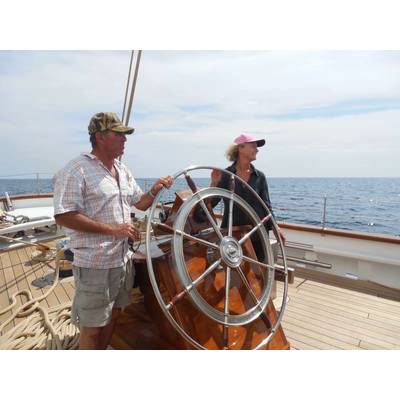
Eastern Shipbuilding Group, Inc. (ESG) announced that the Columbia (ESG Hull 981) a steel hull exact replica of the historic Gloucester Fishing Schooner, has completed her sailing trials. The sailing trials were held on September 18, 2014 directly offshore of the beaches of Panama City, Florida. Ninety-one years earlier, the original Columbia was officially measured on October 27, 1923 just before her race with the Bluenose by Raymond J. Milgate, a marine surveyor of Halifax, N.S. The original Columbia was a 141’ classic wooden hull Gloucester Fishing Schooner built at the historic A.D. Story shipyard of Essex, Massachusetts. The town of Essex was the center for North American Fishing Schooner construction. Designed by the innovative William Starling Burgess, the original Columbia was bred for speed. In the fall of 1923, the Columbia challenged the Bluenose, Canada’s legendary schooner in the International Fishermen's Cup Races held offshore of Halifax, Nova Scotia. Nearly winning the title, the Columbia was narrowly defeated by the Bluenose and was one of the few American schooners to provide a real challenge to Bluenose. Tragedy struck the promising young Columbia on August 24, 1927 near Sable Island, the notorious “Graveyard of the Atlantic”, where the Columbia was lost with all hands in a gale. The Columbia will continue to undergo final outfitting and delivery preparation this fall at Eastern. The Columbia will also be exhibited at the Fort Lauderdale International Boat Show October 30 - November 3, 2014. Working with John W. Gilbert & Associates of Boston, Massachusetts, the design was reengineered with a steel hull instead of wood. An engine room and staterooms were added to the design. Covey Island Boatworks of Lunenburg Nova Scotia built the rigging and spars. Blocks were fabricated by A. Dauphinee & Sons and all the sails were constructed by Michelle Stevens Sailloft, LTD, both from the Second Peninsula, Lunenburg, Nova Scotia. Teak decking was completed by Teakdecking Systems of Florida. Dimensions: Length on deck: 141’-2” Length at waterline: 110’ Beam (molded): 25’-6” Hull and superstructure construction: Steel, ABS Grade A-36 Main Mast: One 17” x 124’-10”, Covey Island Boatworks, Douglas Fir Laminated Lower. Sitka Spruce Laminated Top Mast Foremast: One 17” x 115’-7”, Covey Island Boatworks, Douglas Fir Laminated Lower. Sitka Spruce Laminated Top Mast Certificates/Regulatory: Registry/Flag/Certificate of Documentation: United States of America Construction/Guidance: The vessels hull, superstructure and underwater gear are designed constructed and Classed in accordance with the Lloyds Registry Rules for Building and Classing Steel Vessels. easternshipbuilding.com
Related News
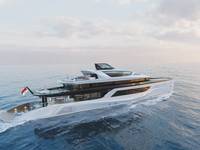
Hakim Wins Feadship Young Designer Award
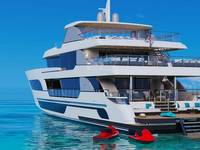
Burger Boat Company Introduces the 142 Atrium Motor Yacht

Bering Unveils New Superyacht Concept
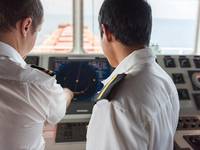
MarTID: 2023 Survey of Maritime Training Practices is Open
Author Yachting Magazine Collection SDYC Library Collection Object ID LB25218 Object Name Book Sub-category 10 Volumes Title Yachting, 1923
Collections & Research
Index to Yachting / MotorBoating / Rudder
Yachting, MotorBoating and The Rudder were among the most prominent magazines writing about boats and yachting in the twentieth and late nineteenth centuries. Article citations below refer to month, year and then page number. To search in a single magazine, enter its name in the search box at the bottom of the “Magazine” column. To search a single year, enter the 2-digit year followed by a colon in the search box below the “Citation” column, for example, for 1942, enter “42:”.
The Rudder, 1891-1950
Rudder magazine was first published in 1891 and soon became one of the most important yachting and boating magazines available. This index, compiled by Library staff member and retired Navy Commander Norman Clarke (1937-1996), concentrates on articles that appeared in the magazine through 1950.
Yachting & MotorBoating
These indexes focus on articles about particular vessels–they are not complete article indices. Yachting entries cover the years 1923-1958, with additional entries from 1907 and 1908. MotorBoating entries cover the years 1931-1975.

YACHTING: Its History In San Diego
by Summer Furzer | Oct 1, 1974 | | 0 comments
The Journal of San Diego History SAN DIEGO HISTORICAL SOCIETY QUARTERLY Fall 1974, Volume 20, Number 4
By Linda M. Pearce Nolte
Images from the article
“Yacht” is an English word derived from the Dutch word jaght meaning a hunt or to pursue, and is short for jaghtschip. The name was given to any of various relatively small ships for pleasure cruising and racing. Sailing for pleasure originated in Holland during the late 1580s when the country grew in wealth. The numerous waterways and canals intersecting Holland provided the opportunity for wealthy residents to use their boats for both private conveyance and commercial reasons. The word jaght grew in stature and eventually signified a splendidly equipped state or private vessel, handsomely and comfortably furnished.
San Diego’s link with the sea has been continuous since its founding, and while boats and ships have been important throughout its history as a means of trade and transportation, for military purposes and in the fishing industry, it was not until 1852 that an organized yacht club was formed for the purpose of boating for pleasure. On March 16, 1852, the first local yacht club, the Pacific Pioneer Yacht Club, was founded. According to the San Diego Herald there were fifteen members, seven of whom were United States military officers, with a variety of sizes of sloops and schooners. 2
The yacht club held its first regatta on April 10, 1852. The Herald reported that it was a gala day for the entire area:
… streets were crowded with lovely ladies and gentlemen decked out in their finery. The streets were crowded with carriages, and excitement was the order of the day. An Indian sac-race was an added attraction. The fleet gathered at Long Wharf, and the commodore set his pennant at 8 a.m.; the yachts moored at 10:30; members were forbidden to accept bids after 11. The vessels were under way at 11; booming-out was allowed, but no sweeping; the race started at 11:30 but the wind died before 12. A light breeze came up at 12:10. At Ballast Point the order was Fanny, Piutus, Gen. Hitchcock, Major Allen, Josephina . At 3:30, the Lavinia was second. The Josephina went aground on the flats abreast of the Playa (Point Loma) but soon got off. The Lavinia was aground for 1/4 hour. The Piutus turned the stake post at 3 1/2, with the Lavinia second. First prize was a magnificent gold-chased drinking-cup valued at $250; second was a silver speaking trumpet; third, a suit of colors. The sac-race was announced at 4 o’clock by the booming cannon from the Plaza in New Town, and was run in three heats. Dinner for members of the yacht club was held at 6 p.m. at the club; admission for gentlemen, $10; for ladies, $5. 3
Nothing more is known about the activities of the Pacific Pioneer Yacht Club. No mention of the club or its dissolution is found in local San Diego newspapers nor is it listed in city directories for this period.
It is not until the late 1860s that reference is found in any significant degree to boating for pleasure. On April 15, 1867, the tiny steamer Pacific arrived from San Francisco with six passengers and some freight. 4 One of the passengers was Alonzo Erastus Horton who was to spark the development of New San Diego. The city grew and prospered under Horton’s guidance. As the population increased, the fishing industry became an important enterprise, requiring boats designed for ocean sailing.
The Columbia River salmon-boat proved a most efficient fishing craft. Its design, which included a beautifully shaped double end, was modeled after those used in European countries bordering on the Mediterranean. Soon several of the fish markets developed similar boats and either sold or rented them to fishermen.
Opportunities for entertainment were sparse during this period in San Diego. Aside from legitimate stage shows which came once every two or three months and a Charter Ball held once each year, there was very little else to do socially. Thus people were inclined toward the natural sports such as boating. Fishermen did not fish on Sundays, and people began borrowing or renting their fishing boats for picnics and eventually for racing or pleasure sailing. A small racing fleet eventually was organized for racing on Sundays.
A local butcher, Charlie Hardy, decided that he would take the lines of the salmon-boat, perfect it, and build the fastest boat he could. When the fish were running it was used as a fishing boat, and when other larger vessels sailed into San Diego Bay, Hardy would sail out, take their orders for fresh meat, sail back to his market, load the meat on his boat, sail back out and deliver it. Hence, he named his boat the Butcher Boy. Hardy also raced the Butcher Boy on Sundays against other boats and completely outclassed them. Deciding that he wanted a boat that would be even faster than the Butcher Boy, Hardy built the first power driven boat in the San Diego area. His meat market was called the Bay City Market, and consequently, he named his power boat the Bay City.
Kent Howell bought the Butcher Boy , and converted her into a true yacht or pleasure boat. She is thought of as the first real yacht on San Diego Bay, and her conversion marks the beginning of true yacht racing in San Diego. 5
Even with the double use of boats for both fishing and yachting, pleasure sailing in San Diego during the middle 1800s was not as developed as it was in Europe during the same period. People in San Diego enjoyed sailing, but did not adopt the traditional accouterments of the gentleman sailor. The white flannel trousers and blue coats were missing. It was not only a lack of wealth, but a lack of people that prevented the development of yachting. The population of the city in 1870 was 2,300, in 1880, 2,637, and by 1887, around 4,000.
By 1885, the Santa Fe Railway Company finished a single track line to San Diego for the purpose of transporting cargo from San Diego to Los Angeles. (Los Angeles did not have a nearby port until 1899 when the city developed San Pedro harbor.) This gave San Diego an advantage since it was the only marine terminal in Southern California capable of handling large amounts of commercial cargo. Those who wanted to take advantage of the anticipated prosperity began investing their money in real estate and new businesses.
As the city’s population increased and as its residents became more affluent, yachting grew in popularity. According to E. J. Louis, an early member of the San Diego Rowing Club, as early as 1883 there was great interest in boating on San Diego Bay which led to the formation of many boating clubs. 6 On June 8, 1886, fifty-five people met in Horton’s Hall to organize the San Diego Yacht Club. W. H. Pringle became the first commodore. This was the first of many boating clubs to form in San Diego after the completion of the railroad, even though the boats were still used primarily for fishing.
The first home of the San Diego Yacht Club was the northerly of the two keeper’s lighthouses at Ballast Point. It was here, on Admission Day, 1891, that the members first displayed their burgee. The club used these quarters until 1898, when, for military reasons during the Spanish-American War, the United States government withdrew the privilege. The club had no regular clubhouse from then until 1903.
On June 1, 1905, the San Diego Yacht Club merged with the Corinthian Yacht Club which had been organized in 1902 and had purchased the D Street boathouse as a headquarters. As a result, the financial difficulties that both clubs were experiencing were eliminated. The burgee of the Corinthian Yacht Club, a red star on a white field, with blue border, and the name of the San Diego Yacht Club were adopted.
Five years later, in 1910, the land adjacent to the Broadway Pier was filled in (D Street Pier), and the club was forced to move again. This time the club purchased the old ferry steamer Silvergate from Coronado Tent City and located it at the foot of Hawthorne Street for its new home. 7 It remained there for four years until an extension to the seawall forced another relocation; and in 1914 the Silvergate was towed to a point west of the ferry slip on Coronado Island.
Many members of the yacht club feared the club would not be able to survive when it was located in distant Coronado. In an attempt to bolster its sagging membership, in 1916, the San Diego Yacht Club accepted the membership of the Coronado Yacht Club. However, this did not prevent the club’s total membership from dwindling.
With the approach of World War I, local yachting activity suffered. According to one yachting enthusiast, the club’s difficulties were multiplied by “discriminatory taxes and senseless red tape.” 8 During the war, the yachtsmen turned their attention to the war effort. Some 29,000 windjammers and motorboatmen throughout the country joined the Navy, and many of them volunteered their yachts for military uses. The San Diego Yacht Club donated the copper sheathing on the Silvergate to the war effort. Soon after, the ferry began to sink and was sold to a wrecker; now, for the fourth time, the club was without headquarters. Toward the end of the war, Secretary of the Navy Josephus Daniels expressed his appreciation for the large number of yachtsmen who had joined active service. He believed that their previous experience in yachting had been of real value as preliminary training for participation in the Navy. 9 Lawrence Perry wrote that,
… no recreative form of activity was in a position to be of so much practical value to the Government when we [the United States] entered the war as was yachting. Passing the fact that there were hundreds of yachts which the Navy Department found of inestimable value, we note the thousands of men familiar with navigation, practical seamanship, or boat handling, who were qualified at once—or with very little training—to enter Government service; there were men who were not only familiar with coastwise waters, tides, currents, and other details essential to patrol duties, but yachtsmen who held the best sort of pilot’s certificates …. 10
With the Silvergate no longer available as a clubhouse, for the next six years the San Diego Yacht Club held its meetings at the Coronado boathouse, in the Chamber of Commerce rooms, in a garage, at private homes of members, and eventually at the Navy Militia Armory located at the foot of Twenty-eighth Street. During these years, as interest in yachting increased, members investigated the financing of a new clubhouse and searched for a location that would provide a sheltered and safe anchorage. The site chosen was in Coronado below Tent City. Finally, on August 18, 1923, the members raised their burgee over the completed clubhouse. The 100 members elected George S. Gay as commodore.
During the remainder of the 1920s interest in yachting in San Diego continued to increase. In 1924, the fourth annual Southern California Yachting Association and the Pacific Coast Yachting Association Regattas were held at the San Diego Yacht Club. There were 112 yachts representing clubs from Vancouver to San Diego and over 1,500 yachtsmen attended the event. The week of racing went so well that improvements were made on the clubhouse and the Roseville Wharf on Point Loma became the headquarters for the larger vessels of the San Diego Yacht Club fleet. In 1926, the San Diego Union newspaper presented a perpetual trophy for a New Year’s Day Race. Oswald Zahn, sailing in Gretchen , won first place, and Joseph Jessop won the Pacific Coast Star Championship in his yacht Windward.
Because of the successful volunteer yachting activity during World War I, the Navy’s interest in yachting increased significantly. In 1927, Jessop asked the Navy if the San Diego Yacht Club could put their boats on the U.S.S. Gannet to be transported to Santa Barbara for that city’s annual regatta. The Gannet , originally a tug, had been converted a few years earlier into a dormitory to carry mechanics and was assigned as a seaplane tender. The Navy agreed, and five Star class boats were on the Gannet’s stern. The crews lived in the dormitory. When they reached Santa Barbara the yachts were lowered into the water for the regatta, and brought aboard when the race was over.
As a result of the successful trip of the San Diego Yacht Club to Santa Barbara on the Gannet , the Navy agreed to transport four boats and twelve men to Honolulu. There the men spoke about their yachts, sold them, and returned to San Diego on a Navy vessel.
In 1928, six boys, ages twelve to fourteen, approached Jessop and said, “we would like to start a Junior Division of the Club.” Having learned to sail at a young age himself, without any money or help, Jessop empathized with the boys. The proposal was almost unheard of because children around a yacht club were considered a nuisance. However, a meeting was held between Jessop, Gordon and Al Frost, Bob Merit, Grant Stone, and Walter Fisch. Jessop remembers that he almost was thrown out of the club because some of the older members did not want those “kids” running around, but the division was formed anyway, and its members were supported with enthusiasm and given financial assistance from the Yacht Club. 11
It was also during this year that the members realized that the sandbar on Coronado was too shallow for sailing in large boats and that the club was too far away from some of the club members’ residences. The people from San Diego were not going to cross on the ferry to Coronado in order to sail. Consequently, the club operated two yachting stations; one was located on Coronado, the other at the Roseville Wharf on Point Loma. Both clubhouses were supplied with restaurants and caretakers. However, it was not until 1932 that the San Diego Yacht Club seriously considered moving the Coronado clubhouse to the Roseville Wharf. By this time nearly all of the members lived in San Diego or on Point Loma. Finally, on January 14, 1932, the clubhouse at Coronado was picked up, put on barges, and floated across to the Roseville site where it was placed on pilings at the end of the dock three blocks from land. This move was a “touch and go” operation because the barge which held the clubhouse had to float high enough so that when the tide went out the clubhouse would rest on the pilings set up on Point Loma. The members were late getting started and had only thirty minutes to spare.
On October 25, 1934, the Federal Government and the San Diego Harbor Commission initiated dredging of San Diego Bay which also provided a channel 200 feet wide and 20 feet deep from the main harbor to the San Diego Yacht Club clubhouse. The dredged material was pumped out and deposited in such a way that it was possible to place the clubhouse on dry land. A sand spit was built up in front of the clubhouse dividing the main channel and the yacht anchorage, forming what is now called Shelter Island. Before the spit was built up, the area known as Shelter Island could be seen only at low tide.
Many San Diegans wanted to establish picnic grounds and an outdoor park on the newly formed Shelter Island. Conversely, others wanted nice clubhouses and first-class resorts with entertainment. Fortunately John Bates, harbormaster at the time, supported both groups. As a result, one side of Shelter Island was reserved for picnic spots and park land, while the other was to have marinas, motels, and restaurants.
As the San Diego Harbor was improved, the San Diego Yacht Club also grew and prospered. In 1935, the club held the Southern California Yachting Association (SCYA) summer regatta. There were over 100 entries, and during the races, Wallazz B. Eaton, who was to be the club’s commodore the following year, broadcast by short wave from the ocean course for the first time in San Diego history.
It was an active period in the club’s history. New tennis courts were built and a bathing beach and game room were completed. In 1932, an intensive drive was launched to refurbish the interior with new drapes and new rattan furniture. A fireplace was added and area rugs were purchased with $1,000 raised by the women members of the club.
In 1937, club member Milt Wegeforth won the International Star Championship (ISC). The San Diego Yacht Club had the honor of hosting the ISC the following year. On September 10, 1938, the club held the first race of the International. There were twenty-two entries with eight countries represented. The winner was Walter von Hutschler from Germany.
As the yacht club gained status in international racing circles, it also continued to enhance its clubhouse. In 1939, a new dining room, lunch counter, ladies lounge, and an office were added. In March, the club held its first tennis tournament.
During September of this same year, although war loomed menacingly over Europe, the United States sent three Star crews and their boats to Kiel, Germany, for the International Star Championship. Milt Wegeforth represented the San Diego Yacht Club. One of the yachts arrived in Holland instead of Germany and had to be towed by taxi to Kiel. The international races began with thirty boats. Unfortunately, by the start of the third race, Hitler threatened other European countries by establishing his “Polish corridor.” In an attempt to complete the international competition more rapidly, two races were held each day. Soon after the seventh race Wegeforth and his fellow sailors discovered there was no way to ship their Stars back to the United States. The American sailors took the train to Copenhagen and booked third class passage on a neutral Norwegian ship bound for New York. Before leaving, one last attempt was made through custom house brokers to have their boats shipped to the United States. Eventually, a broker said he could do it if no questions were asked. One week after they arrived in New York, the three American Star boats arrived on a neutral Danish freighter.
Twenty-seven months after the International Star Championships were held in Germany, the Japanese attacked Pearl Harbor on Oahu, Hawaii. One day later, on December 8, 1941, Congress declared war on Japan and three days later the Axis powers declared war on the United States. By 1942, San Diego Yachtsmen found buoys blacked out and sailing areas limited, with registration of boats and identification of all yacht personnel required.
CHULA VISTA YACHT CLUB
Three years after the formation of the San Diego Yacht Club, another club was formed. Irene Phillips, in The Chula Vista Story , dates the Chula Vista Yacht Club as early as 1889.
…. a Fourth of July picnic was held in 1889. There was a makeshift landing at the undeveloped foot of “F” Street which was used by a small group that called themselves the Chula Vista Yacht Club. In 1897 they asked the Land and Town Company to help them build a wharf. The Company responded by giving railroad iron and heavy flooring which they took from the railroad wharf in National City. The club held an annual Regatta each year … they incorporated on February 24, 1914 for “mutual improvement, social intercourse, and to encourage sports.” Greg Rogers became President. 12
At the end of the wharf the club built a redwood building and used the southern part of San Diego Bay as their racing and sailing area, an area much deeper at the turn of the century than it is today. Members of the yacht club sailed over to Brickyard Cove (now Coronado Cays) for picnics, or sailed further north to Glorietta Bay at Coronado. In the early 1900s Chula Vista was regarded as a gentleman’s farming area and was considered the principal lemon growing area for the United States. The yacht club provided social status for many of the farmers in the area as well as the city residents. The members developed the largest one-design club on the Pacific Coast. (All boats were constructed to the same set of specifications and measurements). The fleet consisted of eleven, thirty-foot sailboats. 13
In August, 1901, the first race for the Montebello Loving Cup, donated by Mrs. Cook to the club, was held. The six entrants were: Captain Remert in Josephine ; Captain Belcher in Hobo ; Captain Berger in Lark ; 14 Captain Daschbach in Kelple ; Captain Gould in Frolic ; and Captain Howe in the Adah B . The winner of the three-mile triangle race was Captain Remert in Josephine. 15
On March 3, 1915, members of the club announced that the wharf was in need of repair and appealed to the City of Chula Vista for financial assistance. The city council refused their request because they felt the landing was too far from town to be patrolled by the marshal. Less than a year later, however, the city council changed its mind. On January 28, 1916, excessive rainfall washed away the Otay Dam and eroded earth from the sides of the Sweetwater Dam. Soon after, Sweetwater Valley was flooded, water mains destroyed and Edgemere Road and the railroad tracks to Chula Vista washed away. Eventually the National Avenue Bridge collapsed, isolating Chula Vistans from the rest of the county except for a few boats which were able to bring mail and supplies from San Diego. One of the boats which brought provisions to Chula Vista was the Sea Queen , owned by the Crescent Boat Company. These boats used the wharf of the Chula Vista Yacht Club. When the emergency was over, the city council was grateful and offered to repair the wharf. Instead, the yacht club agreed to repair the wharf and the city graded “F” Street all the way from the town to the pier. 16
Unfortunately, debris from the 1916 flood filled the South Bay area, and it was impossible for the larger keeled boats to sail there. 17 On February 24, 1924, the yacht club property was sold to the City of Chula Vista for $1,500, and the club relocated to the wharf of the Hercules Powder Company. 18
In the late 1920’s there was another heavy rainstorm. The Otay River carried so much debris and dirt into San Diego Bay that the area became too shallow for sailing. Even today the only boats able to sail successfully on the southern part of San Diego Bay are the shallow hulled boats such as hoby cats or skiffs.
The Chula Vista Yacht Club like the Pacific Pioneer Yacht Club faded into obscurity, and the last known about the club is that its clubhouse was dismantled on March 18, 1934, and taken 250 miles south to Scammons Lagoon in Baja California where it was used for loading salt. 19
JUNIOR YACHT CLUB
Sometime between 1910 and 1913, Dr. Joseph E. Gahan broke away from the San Diego Yacht Club and formed the Junior Yacht Club. 20 Gahan believed the San Diego Yacht Club was becoming too socially oriented with less and less interest in sailing. Cecil Burwell assisted Gahan in obtaining permission from the United States Navy to build a boathouse at the end of the Naval Militia Wharf located at the foot of Twenty-eighth Street. This was the only yacht club which admitted boys as young as sixteen years of age. Prior to this, the usual age was twenty-one.
Today the Junior Yacht Club is remembered by only a very few old yachtsmen who cannot recall when the club ceased to exist. It is probably a good assumption, however, that the club disbanded shortly after 1917 when the United States declared war on Germany.
CORONADO YACHT CLUB
The Coronado Yacht Club was first organized between 1913 and 1916, but with the start of World War I, the club was dissolved and it was not until 1932 that it was reorganized. The club’s original members, however, joined the San Diego Yacht Club, after all debts were paid. 21
In 1932, with the reorganization of the club, Henry Weston was elected commodore. Members rented the boathouse from the Hotel Del Coronado for $15 per month. (This boathouse is now the Chart House restaurant in Coronado.) Meetings were held there until 1947, when the members moved to their present location at the head of Glorietta Bay 22 .
In 1947, two old WAVE barracks were purchased from the Navy, floated to the head of Glorietta Bay, and installed as the new clubhouse. Teddy G. Ackerman recalled that “Mrs. Elmer Muhl, other women members, and myself, painted the clubhouse, bought plants with our own money and landscaped the club grounds.” 23 The club’s charter was granted from the State of California soon afterwards.
In 1941, the Coronado Yacht Club hosted the James Craig Predicted Log Contest, but the event was not held again until 1946, after World War 11. 24 From 1946 to 1971, the ceremonies pertaining to the first half of the contest were hosted by the Coronado Yacht Club, with arrangements made for the awarding of trophies to be held at the Hotel Del Coronado. This contest, held on the yacht club’s annual opening day, represented one of San Diego’s biggest yachting events. In recent years the San Diego Yacht Club has hosted the event.
In January, 1948, the club’s first newsletter, the Whisker Pole , originated and named by club historian Ackerman, was issued. In the 1950s and 1960s, the club membership steadily grew, and, by January, 1974, club membership had reached 400. 25
SOUTHWESTERN YACHT CLUB
In 1924, there were no yacht clubs on the San Diego side of the bay, the San Diego Yacht Club having moved to Coronado. Mud flats extended from the embarcadero all along the shore. A year later, Dr. Ernest Percy Chartres-Martin and Stanley Hobson, disgusted with the lack of facilities for yachtsmen in San Diego, decided to organize a club and build a pier for yachtsmen only, because fishermen had priority for the best locations on the piers already in existence. Chartres-Martin and Hobson called a meeting in March, 1925. 26
According to Sea and Pacific Motor Boat , the charter members of the Southwestern Yacht Club were: Dr. E. Chartres-Martin, J. Stanley Hobson, Graham Shand, Dr. McKellar, R. G. Fenn, Al Stewart, and Michael Eff. 27 However, according to the memory of Graham Shand in 1947, the charter members were: Dr. Chartres-Martin, Graham Shand, Dr. McKellar, Earl Mencke, Roger Bryan, Bob Bowman, and William Rolfe. 28 Because no records were kept during the years previous to 1947, accurate data is not available. Perhaps the first group consisted of the original organizers and the latter were the true charter members.
The first meeting was held in a shanty at the head of Mencke’s pier. “Ways and means were discussed, and Shand and Hobson were appointed to locate a site for the club, and to get the approval of Joe Brennan, who was Captain of the Port at the time.” 29 Eventually, Hobson suggested the club be named the Southwestern Yacht Club. 30
Subsequently, while exploring the bay and shore in a skiff, Shand and Hobson discovered that the only feasible spot in which the club would be able to locate was at the foot of Grape Street. Upon further investigation, it was decided by Brennan that this site was available for a rental charge of $1 per month.
Through the influence of Chartres-Martin, the Street Railway Company donated rails for construction of a pier. Heavy timbers and 2 x 4’s four feet long were purchased from Whiting-Mead Company for $27. Club members obtained additional timbers needed to complete the pier from a sea wall originally built by the city. Shand recalled, “[we] decided that the timbers would serve a better purpose on our pier than holding back the tide water on the flats, which were fast filling in anyway.” 31 Within one month, the pier was completed and ready for operation.
In the late Fall of 1926, the first clubhouse, 20′ x 40′ enhanced by a large fireplace and a tower housing a flashing light, was completed at a cost of $700. Consequently, the club membership increased to 42 by the end of the year. Dues of $3 per month were established, and a second 100 feet of frontage added.
In January, 1927, the club ground was landscaped by member F.A. Bode. (Bode had been responsible for landscaping at the 1915 Exposition in Balboa Park.) The club ground was San Diego’s first landscaped waterfront area. 32
Southwestern’s first regatta, under the banner of the Washington’s Birthday Handicap Invitational Race, was held on February 27, 1927. 33 The Chamber of Commerce supported preparations and local merchants donated six cups for prizes.
In 1934, the San Diego Yacht Club proposed a merger of the two clubs. Their proposal was turned down by one vote. Nevertheless, many of the larger boat owners were allowed to join the San Diego Yacht Club without paying an initiation fee. Five years later, in 1939, the Washington’s Birthday Handicap Trophy was deeded to the San Diego Yacht Club after a request by former Southwestern Yacht Club members. Today, however, this decision has been greatly regretted. 34
With the start of World War II, Port Captain Brennan hinted to the members of the Southwestern Yacht Club that they would have to relocate. As a result, members requested that the new site be at the foot of Qualtrough Street on Point Loma. This request was denied because the site had already been leased to sport-fishing groups.
In 1941, the members chose to move to a location near what later became the Harbor Boat and Yacht Yard. On October 31, 1941, the clubhouse at the foot of Grape Street was sold to the Lemon Grove Post of the Veterans of Foreign Wars for $550. With this money and a loan from the San Diego Trust and Savings Bank, the building of a second clubhouse began. However, progress was impeded due to the rationing of material brought on by World War II. Construction had barely begun when members were notified that they would have to relocate for the third time. Consequently, the building was constructed on skids with flexible utility connections in anticipation of a future move. Finally, in 1946, the land on which the clubhouse was located was leased by the City to the Harbor Boat and Yacht Yard, and the Southwestern Yacht Club moved 400 feet westward. In 1948, with a membership of 160, a 20′ x 50′ addition to the clubhouse was constructed.
On March 27, 1951, the clubhouse was relocated to its present site at the foot of Qualtrough Street. Rent was established at $1 per member or $250 per month, whichever was greater. The club grew to 250 members by 1955, the construction of a fifth dock began, and an electric hoist was installed.
In 1970, the club faced severe financial problems and possible dissolution because of inflationary taxes and rent levied by the San Diego Unified Port District. It was during this time that members considered relocating to Mariner’s Point in Mission Bay or be forced out of existence. Fortunately, in 1971, a provision was written into the club’s lease with the Port District recognizing the value of the club’s recreationally oriented activities and calling for a rental charge of one-half of the normal commercial rate on their leased tideland property.
With the lease approved by the Port District, Southwestern Yacht Club members began to implement new building plans. However, before a loan was procured, a title search was necessary. According to Edward S. Soltesz, “this was not an easy thing to get done. Major insurance firms in San Diego refused help when it became known that Southwestern’s property had never been recorded in the official records of the County Recorder.” 35 Eventually, however, assistance was obtained from the First American Title Insurance Company of Los Angeles. The title company’s investigation proved that Southwestern’s lease was clear. With the title company’s guidance, members then sought to make sure that the lease was in conformance with the laws of California regarding the leasing of public lands to private concerns. It was then necessary to present club by-laws to the State Lands Commission for review and approval. The Commission requested the club to change certain sections of the by-laws considered not in accord with State laws. After these changes were made the Commission declared the club’s lease valid and a Title Insurance Policy was granted, thus enabling the club to borrow money successfully. 36
With a current membership of 400, the Southwestern Yacht Club is preparing for events which will commemorate their Golden Anniversary in 1975.
THE MISSION BAY YACHT CLUB
The Mission Bay Yacht Club was chartered in 1927, with Thomas O. Scripps serving as the club’s first commodore. According to Scripps, the yacht club was started by his brother-in-law, Austen T. Brown. 37 While visiting Coronado’s Tent City in 1925 Brown and Scripps noticed a small, dirty, neglected flapper (a popular boat at that time, built by Phillips and Stewart, one of the larger boat building firms in Los Angeles) tied to a float in front of the San Diego Yacht Club. Brown inquired and learned the boat belonged to the widow of a naval officer, and that it was for sale. Because it was so dilapidated, he paid $50.00. When new, the boat sold for $150.00. Brown and Scripps took the boat to Mission Bay where they started cleaning the moss out of it, only to discover that they were working with, as Scripps recalls, “a boat that was almost destroyed before we started.” 38 They continued, however, until the little flapper was again seaworthy.
Brown sailed almost every weekend. His competitive spirit prompted him to challenge other sailors to race on Mission Bay. This was the only flapper on Mission Bay at the time, and because the other boats were much larger, they always won, but, according to Scripps, “Austen could not have cared less; all he was interested in was whether he was closer than the last time when he finished.” 39
Brown and Scripps approached Alonzo de Jessop, Scripps’ uncle, who suggested they form a yacht club with provisions for a race committee chairman. There was a big promotion in those years of Mission Bay real estate. Brown and Scripps thought they could get the real estate investors to support a yacht club financially and in return make them life members of the club. They spoke with numerous people and found a real interest in the project, especially among members of the San Diego Yacht Club who had considerable experience. Then they contacted the people of Pacific and Mission Beach to encourage their participation. When Scripps and Brown called an organizational meeting, the response was enthusiastic and the Mission Bay Yacht Club was formed.
The new club raised $2,000 and built the first clubhouse—four walls and a roof built on stilts—on Crown Point where members obtained a fifty-year lease from the State of California.
Leo Carroll, who worked for the Southern Pacific Railroad, became the first race committee chairman. F. T. Scripps, Tom’s father, gave Carroll an old ten-gauge, double-barrel shotgun to use. At first Carroll took the shot out of the shells, however, the gun would not make any noise and the shot had to be put back in. “Although Leo would shoot the gun up in the air, it would still rain bullets.” 40
After World War II, the club secured a lease on three acres of land and three acres of water on El Carmel Point, the club’s present site. Plans were made to float the clubhouse from Crown Point to El Carmel Point, but “a closer look at the old lease revealed the improvements could not be moved.” 41 The members of the club then decided to build a new clubhouse on the new site.
During this same period Carl and Teddy Ackerman brought to the San Diego area the first Lightning class sailboat, the Tu Tu, which had originally been located at Pearl Harbor during the bombing in 1941. Two fleets were organized in the San Diego Bay area before Bill Pirie and other members of the Mission Bay Yacht Club secured a charter for Fleet No. 194 at the club. These larger boats could not be introduced to the Mission Bay area until dredging began.
Today, with Mission Bay fully dredged and beautifully developed, the Mission Bay Yacht Club is the only yacht club on the bay. According to Pirie,
The club has always been a small boat sailing club, primarily. We do have a number of motor boats. It has always been quite a family club and we have always encouraged juniors. The club is respected for its small boat sailing around the world. In fact, one of the most famous yachtsmen from the Mission Bay Yacht Club is Earl Elms. He has been five times world champion in the Snipe division. 42
Club members feel they have lived up to the original aim of the charter members, “A Corinthian Yacht Club where, regardless of station in life, we meet on a common ground—our favorite pastime, yachting.” According to Joe Hill, past commodore, the Mission Bay Yacht Club is still made up of amateur yachtsmen, people who have joined for the pleasure of sailing rather than for the prestige of belonging. 43
SILVER GATE YACHT CLUB
On March 5, 1952, nearly twenty-five years after the formation of the Mission Bay Yacht Club, twelve men met at the Point Loma Anchorage Lounge to organize the Silver Gate Yacht Club. According to Jack A. Fulton, a club founder, “John Bates attended this meeting and was instrumental in inspiring the club’s formation. Although not present at our first meeting, Alonzo de Jessop, who was usually known as the father of yachting in San Diego, gave us a lot of encouragement and help.” 44
The members received their charter from the State of California in November, 1952. 45 Charter members were: Beverley E. Alexander; Harvey L. Beagle; Wynne Bowen; Kenneth C. Brown; Charles W. DeWitt; Kenneth E. Eaton; Mildred Elder; Bruce K. Englehorn; Jack A. Fulton; Robert L. Gates; Lieut. Clarence U. Gebson; William P. Hall, Jr.; M. R. Hutchison; M. Dean Kennedy; Lawrence C. McArthur; D. C. Mitchell; John E. Nissen; B. L. Rhode; William J. Rumsey; Maxine Updegraff; Charles D. Willits; and Roy Miles Wood.
Most of the original club members were yachtsmen who chose not to join the established yacht clubs because of high initiation and membership fees. Silver Gate Yacht Club fees at that time were $10 for initiation and $9 per month dues.
In April, 1954, the club became a member of the Southern California Yachting Association, and one month later, a member of the Southern California Cruiser Association. By the end of 1954, plans for a clubhouse and dock were completed. Charter member Robert Gates contracted to build the docks, and another charter member, Roy Wood, contracted to build the clubhouse.
In 1960, “Doc” Shorts started the Wheelchair Regatta to take handicapped persons for a cruise on San Diego Bay. Shorts became ill the following year and James Spade has run the regatta since then. According to Lawrence W. Baldwin, “at the last regatta [usually held on the last Sunday in June] over 300 handicapped persons participated.” 46
The Silver Gate Yacht Club, according to Baldwin, is known along the coast as a cruising club. Yachtsmen have come from Canada, Washington, Oregon, and Northern California seeking cruising information from club members. Presently, the yacht club is not only the smallest yacht club on San Diego Bay, with a membership of approximately 150 (the club’s maximum due to their limitation in land space), but it is also the only non-commercial operation on Shelter Island. 47
POINT LOMA YACHT CLUB
In 1960, the Point Loma Yacht Club was organized with articles of incorporation filed on January 17, 1961. The club was created by yachtsmen whose boats were docked at local commercial anchorages, but who desired to race with the established yacht clubs in San Diego.
The club was headquartered at the Half Moon Inn with a unique arrangement whereby members were allocated an entire finger of slips. A locked gate was built across the finger at the point where the occupancy of the club members began. As membership grew, more slips were required, necessitating the moving of the gate further up the finger. Each move became an occasion for celebration. Major club activities centered around club cruises to Catalina Island and the Coronados.
Eventually, club membership grew to 73 with 35 yachts, until April, 1962, when it merged with the Southwestern Yacht Club.
CORONADO CAYS YACHT CLUB
In June, 1972, Joe Fitzpatrick addressed an open letter to the residents of the Coronado Cays community inviting them to attend a meeting at the Jamaica clubhouse for the purpose of organizing the Coronado Cays Yacht Club. At the meeting, officers were elected including Arthur W. (Bud) Holderness, commodore; William H. Dennick, vice commodore; Guy Chilberg, rear commodore; Wrenn H. Lawrence, fleet power captain; and George A. Lasko, fleet sail captain. The Coronado Cays Company assisted in efforts to organize the yacht club and offered the former office suite of developer Cedrick Sanders for use as a temporary clubhouse. 48
The club’s first race, the Coronado Cays Classic, was held on September 10, 1972. It was then included in the regular program and held once a month. An annual Ranger Round-up Regatta was started on May 11, 1974, with twenty-one yachts entered. In January, 1973, the Cays Company moved the club facility to its present and permanent home on Grand Caribe Isle. Early in 1973, the club’s charter was granted by the State of California. By 1974, membership increased to 150. Most members are residents of the Coronado Cays Community. Initiation fees are $100 per year with $24 dues collected each quarter. 49
ROWING CLUBS AND CREWS
SAN DIEGO ROWING CLUB
In 1888, the Excelsior Rowing and Swimming Club was formed with its first quarters at the foot of E Street, now Pacific Highway and E Streets. On July 11, 1891, an agreement was signed by President Walter Carnes, Captain J. G. Decatur, and Secretary W. J. Parker with L. A. Chandler. Through this agreement, Chandler was to provide accommodations for the club at a rental of $15 per month. He was also to alter his boathouse on the Fifth Street Pier for the club’s uses. In 1892, the members changed the name to the San Diego Rowing Club so it would be more representative of the entire city. The membership count was 112, total available assets were $243.62, and the club ordered two new shells of “the latest approved design” from Al Rogers of San Francisco. 50
In July, 1895, three years after the name change, the San Diego Rowing Club was incorporated with four of the original signers and life members still active—Edgar 0. Hodge, W. W. Whitson, E. J. Louis, and Albert E. Johnstone.
In 1900, the club moved to the Pacific Steamship Landing Dock at the foot of Fifth Street. From the dock there was a little railroad which carried passengers up to the beginning of Fifth Street where they could catch streetcars for other parts of town. Directly opposite the rowing club on the other side of the dock was the Johnson Swimming pool. Adjacent to the pool was the Zlac women’s rowing club. 51
Members of the rowing club originally rowed in skiffs which were open cockpit boats with sliding seats. Later they rowed in barges, a heavier open cockpit boat, four-oared with a coxswain. In 1892, they began rowing in shells which were four-oared without coxswain, marking the beginning of competitive shell racing for the club. Today the club has single-, double-, and four-oared shells for its members to use, and one eight-oared.
By the early 1900s the rowing club was the most important men’s club in San Diego. The membership grew at one time to 1,200, and it was said that anyone of importance was a member of the San Diego Rowing Club; the mayor, councilmen, president of a bank, and the president of the gas company all belonged. Membership was much more restricted then than it is today. Four hundred of the members were involved actively in rowing.
The club became a training ground for young athletes. There were boxing teams, four handball courts, canoes, basketball games, horseshoe pitching, bowling, and one of the best swimming teams in the nation. Along with these activities were dances, suppers on Brennan Island, and watermelon festivals.
Rowing became a prestigious activity. It was an honor to make the crews. There were junior, intermediate, and senior classifications. Most of the regattas were held on July 4, sometimes in San Francisco, and occasionally a regatta was held in Alameda around the estuary near the University of California rowing course.
When the regattas were out of town, rowing club members volunteered equipment and money to the crews sent to represent the club. Depending on where the regatta was located, the crews travelled by steamship or train.
These regattas were originally raced in barges and the courses were three-quarters to one and one-half mile turning courses. When the shells came into the use the races became straight-aways. The distances varied until the course was set at 2,000 meters, which is now the Olympic standard.
The regattas in San Diego were usually held off the Coronado shore. However, some took place on the main bay from North Island to the rowing club. The main bay course was the toughest because of the rough water created by commercial vessels. Eventually the courses were relocated to the lee side of North Island.
Rowers in the club were augmented at times by college and high school boys who wanted to continue the sport. Some eventually became coaches for the club, including Del Beakley, Frank Balhon, Max Winter, Dick Jessop, Louis Volsel, Anderson Borthwick, and Ted Stymen.
The San Diego Rowing Club at the present is having difficulties. San Diego citizens have available a wide variety of recreational opportunities; consequently, interest in rowing has decreased and the club’s prestige has dwindled. With the increase of commercial vessels on San Diego Bay, the present location for rowing is unsuitable. The large wakes made by these vessels make rowing impractical. In negotiations with the City of San Diego, the rowing club has expressed its desire to relocate to Santa Clara Point on Mission Bay where there are long stretches of protected, smooth water where the crews can work at least five miles in order to develop the necessary stamina. The City is hesitant to lease any more land in Mission Bay at this time, but has suggested that the San Diego Flood Control Channel adjacent to Mission Bay is adequate for rowing purposes and suitable for the club’s activities.
Long-time club member Anderson Borthwick points out that the channel is a poor site for rowing because of the hazards. There are abutments on bridge pilings that can ruin a shell in seconds. “Peculiar as it may seem, if there is an obstruction in the waterway, even though you are watching all of the time, the boats [might] collide.” 52 Also, National, Intercollegiate, or Olympic tryouts or contests cannot be held on a course that has obstructions such as those found in the Flood Control Channel.
ZLAC ROWING CLUB
Four years after the commencement of the San Diego Rowing Club, four girls, Lena, Agnes, Carolyn, and Zulette formed a small club for teenagers, a club which rowed on San Diego Bay in a leaky skiff. 53 Lena, Agnes, and Carolyn were the daughters of Captain Albert Alexander Polhamus, who was a pilot on the California coast for thirty-six years. During that time he was also a port captain in San Diego and captain of the Spreckels Company tug, the Santa Fe . He was also one of the men who encouraged the dredging of San Diego Bay’s main channel. Zulette Lamb was a good friend of the three Polhamus girls. In 1895 this small club was incorporated, becoming the first woman’s rowing club in San Diego. Eventually the girls’ interest in rowing inspired others in the community to take up the sport as a recreation.
Soon there were many crews on the bay, the State Normal School crews, the Colombia (1899), the Gondoliers (1895), the La Felucca (1895), the L’Esperance (1895), the Water Babies (1897), the Mariners (1899), the La Sierna (1899), the Las Corsarias (1901), the Olympia (1901), the Oceanic (1901), the White Caps (1901), the Nereids (1901), the YMCA (1904), the Nautilus (1904), and the YWCA (1905). Zlac is the only club that has survived. 54
Zlac invited the White Caps and the Mariners to merge with them. Fortunately, these two crews accepted the invitation because Zlac had only five cents in its treasury and some outstanding debts. According to Marjorie N. Breitenbach, past Zlac historian, “the club has been almost broke several times but never quite that broke.” 55 The clubhouse was originally located at the foot of Market Street about where the Navy pier is now.
In 1933, Mrs. F. D. Scripps donated a piece of land on Mission Bay to the club. There was a great deal of disagreement at that time about the location. Mission Bay was wild and isolated, and transportation from town to the clubhouse was a problem. The club moved in spite of these disadvantages.
During the World War II, club membership suffered from a severe attrition rate, the major cause being gasoline rationing. Many members did not want to retain membership in a club they would not be able to enjoy.
Today there are 750 members from ages 15 to 80. One of these members is Mrs. Patty Wyatt whose father is Clem Stose, past commodore of the San Diego Yacht Club. Mrs. Wyatt and Anderson Borthwick of the San Diego Rowing Club were two of the .people responsible for the San Diego 1973 Crew Classic which was held on Mission Bay on April 7, 1973. It was a national invitational regatta which featured the first appearance of the United States Naval Academy crew on the West Coast. The competition also included the University of Washington, the Western Sprint Champion in 1972. 56
The club is divided into crews. Thirty girls age fifteen are admitted every June and are classified as sub-juniors. When these girls reach college age they are classified as Mariners. Memberships in these crews can be opened and closed periodically by their participants.
Through the years Zlac has retained its prominence as the only women’s rowing club in San Diego. However, even now, when the club seems to be at its peak, it is facing a problem which might cause another severe drop in membership. The club’s tideland lease is about to expire, and the City of San Diego does not intend to renew it because it wants public access to the bay at the site. There is also talk of taking down all the piers. This would create a hardship for the club’s participants because their pier is used to hoist the shells into the water.
STATE NORMAL SCHOOL CREWS
The San Diego Rowing Club and the Zlac Rowing Club were inspiring factors for encouraging rowing. Within one year after the organization of the State Normal School in 1897, rowing became an active part of the collegiate physical education program as well as the school’s social structure. Mr. Lewis B. Lesley, professor of History at the school, wrote,
In the early days of the State Normal School the physical education program was indeed a problem. No facilities were available in the original home of the school … But there was San Diego Bay … Thus there came into being the first rowing club, renamed the San Diego State Normal Rowing Association in 1898. During the first years, almost all of the social life and physical activity of the school centered around the Rowing Association. The three original crews were known as the Sylphs, the Octopus, and the Asparas. 57
A school yearbook, the White and Gold , lists six other Normal School rowing crews; the Pristis (1898), the White Ducks (1902), the Rhine Golds (1904), the Dog Watch (1899), the Argonauts (1905), and the Glaucus (1904). 58
[These crews] were made up exclusively of girls, although the faculty, including President Black, formed a crew to join in the activity. A few crews were formed by boys, but the male members of the student body never reached the stage of formal crew organization. (By 1906) the physical education department had been divided into three groups: the Rowing Association, the Girls’ Athletic Association, and the Boys’ Athletic Association. By 1921 the women’s rowing crews at this time had become very selective in their choice of girls. Miss Tanner decided to correct this tendency… In 1923, she brought the Women’s Athletic Association … on campus … and the rowing crews, as social organizations, went out of existence. Rowing became merely one of the sports offered in the physical education program. Many of the old crews were reorganized as sororities through the years 1923, 1924, and 1925. By 1934 rowing was dropped from the curriculum because of the distance from the bay, and gone was the last connection of the women with one of the college’s oldest and finest traditions. 59
Today, although there are relatively fewer yacht clubs in San Diego than at the turn of the century, club membership has increased, and people are joining the existing clubs for the pleasure of sailing rather than for the prestige of belonging.
Interest in yachting has increased so much that local colleges and universities now offer many forms of boating as part of their physical education curriculum. Marinas offer lessons through boat rentals. Some boat dealers provide free lessons with each boat they sell. There are also two free land-based boating courses offered by the United States Power Squadrons, a non-profit organization dedicated to boating education. The United States Coast Guard Auxiliary is devoted to safe boating and offers lessons on rules of the road, safety, knots, and handling line. The City of San Diego offers lessons on Santa Clara Point in basic and advanced sailing. For military dependents, courses are given at the Naval Training Center, and at the Marine Corps Recruit Depot. Moreover, during every Easter vacation period the American Red Cross offers courses on sailing on Glorietta Bay at Coronado.
Yachting has become an important part of the San Diego economy, culture, and physical environment. The benefits of yachting have increased significantly in the last twenty years. The San Diego Union, in 1950, reported there were 2,300 pleasure boats in San Diego County. 60 According to Ken L. Fairbrother, Acting Manager, Vessel Registration Section of the Department of Motor Vehicles, in 1960, there were 12,071 vessels; in 1970, there were 22,327 vessels; and, by 1972, boat registrations increased to 25,054, ranking San Diego County fifth statewide in total vessel registration. Of these boats, 24,193 were registered as pleasure vessels. 61
Economically these yachts provide a source of revenue for San Diego County. They also provide a yearly income for many of the residents in San Diego; ship chandlers, boat builders, and sail makers, to name but a few.
Commercial marinas have been built so those without their own boats may rent boats by the hour or day. Thousands are attracted year round to San Diego Bay and Mission Bay Aquatic Park solely for yachting, adding to the city’s tourist income. The city in return has created nine public launch ramps for interested yachtsmen.
Aesthetically, yachts have added beauty to the San Diego landscape, especially when the rainbow-colored spinnakers are billowing out from ships’ bows. Even when these delicate but sturdy vessels are moored, docked, or on trailers, they have a tailored appearance.
Recreationally, yachting has branched out in many areas. Along with pleasure sailing, there are informal races, organized regattas, and marlin derbies to name a few. Yachting truly “offers a varied play of nature’s beauties” complementing San Diego’s natural amenities, contributing to its economic welfare and generally enhancing the lives of the city’s residents.
1. Manfred Curry, Yacht Racing: The Aerodynamics of Sails and Racing Tactics (rev. ed.; Diessen-Munich, Germany: Jos C. Huber, 1930), p.3.
2. San Diego Herald , April 10, 1852, p. 10.
4. Elizabeth C. MacPhail, The Story of New San Diego and its FounderAlonzo E. Horton (San Diego: Pioneer Printers, 1969), p. 11.
5. Joseph F Jessop, private interview at the San Diego Yacht Club, San Diego, January, 1973.
6. San Diego Rowing Club, San Diego Rowing Club, 1888-1947 (San Diego: San Diego Rowing Club, 1947), p. 1.
7. The Tent City, south of Hotel del Coronado, consisted of more than 600 tent houses, palm cottages and bungalows, a dance pavilion, amusement row, main office, band pavilion, cafeteria, grocery and ice cream parlor. There was also a news stand and information bureau located on the main street opposite the office building which included the telegraph and post office. Telephones were also situated in different parts of the resort for the convenience of the patrons.
8. Joseph E. Jessop, private interview at the San Diego Yacht Club, San Diego, February, 1973.
9. Lawrence Perry, “They’re in the Navy Now; Yachting Has Gone to the War in Earnest,” Country Life , August, 1918, p. 33.
11. Jessop, private interview, January, 1973.
12. Irene Phillips, The Chula Vista Story , 1868-1968 (National City: South Bay Press, 1968), pp. 55-56.
13. Jessop, private interview, January, 1973.
14. The design of the original Lark, owned by a Mr. King of the New York Yacht Club, was printed in the 1898 issue of Rudder.
15. San Diego Union , August 30, 1901, p. 6.
16. Phillips, op. cit., p. 56.
17. Today, flat bottomed boats, however, have very little problem sailing on this portion of the bay.
18. Phillips, op. cit., p. 56.
20. Jerry MacMullen, telephone interview, San Diego, February, 1973.
21. “History of the Coronado Yacht Club,” Sea and Pacific Motor Boat , March, 1956, p. 1.
22. Teddy G. Ackerman, private interview aboard her yacht Bluebird , San Diego, August, 1974.
24. The James Craig Predicted Log Contest is the oldest Power Boat race in the world. It was organized in Boston in 1914. Prior to 1941, yachtsmen on the West Coast were not racing for its beautiful trophy. C. King Brugman convinced these men that the race could be held successfully on the West Coast. As a result, the contest has been run annually since 1946. The first half is from Long Beach to San Diego, with trophies awarded; the second half from San Diego to Long Beach, with trophies awarded.
25. Ackerman, private interview, August, 1974.
26. “History of the Southwestern Yacht Club,” Sea and Pacific Motor Boat , December, 1956, p. 1.
28. Graham Shand, historical notes given to the Southwestern Yacht Club, 1947.
30. According to the San Diego Union , November 21, 1916, there was a Southwestern Yacht Club organized by a group of men in which J. Stanley Hobson’s father, J. C. Hobson, was a member. Unfortunately, this club’s demise shortly followed. It is believed, however, by current members of the Southwestern Yacht Club, that J. S. Hobson’s suggestion of this name was from his past association as a boy with his father’s club.
31. Shand, op. cit.
32. Edward S. Soltesz, “Reflections From Our Historian,” Mooring Line , June 1974, p. 6.
33. Soltesz, Mooring Line , July 1974, p.6.
34. Soltesz, private interview at the Southwestern Yacht Club, San Diego, August, 1974.
35. Soltesz, private interview at his home, August, 1974.
37. Thomas O. Scripps, private interview at his home, San Diego, March, 1973.
41. William Pirie, private interview at his home, San Diego, February, 1973.
43. Joe Hill, private interview at the Mission Bay Aquatic Center, San Diego, January, 1973.
44. Jack A. Fulton, private interview at the Silver Gate Yacht Club, San Diego, August, 1974.
45. “History of the Silver Gate Yacht Club,” Sea and Pacific Motor Boat , March, 1957, p. 1.
46. Lawrence W. Baldwin, private interview at the Silver Gate Yacht Club, San Diego, August, 1974.
48. George A. Lasko, private interview at the Coronado Cays Yacht Club, Coronado, August, 1974.
49. Lasko, telephone interview, August, 1974.
50. San Diego Rowing Club, San Diego Rowing Club . 1888-1947 (San Diego: San Diego Rowing Club, 1947), p. 1.
51. An acronym from Zulette Lamb, Lena, Agnes, and Carolyn Polhamus, the original charter members of this club.
52. Anderson Borthwick, private interview at his home, San Diego, March, 1973.
53. This was probably the beginning of women’s rowing in San Diego.
54. Marjorie N. Breitenbach, private interview at the Zlac Rowing Club, San Diego, March, 1973.
56. San Diego Union , March 15, 1973, p. COI.
57. Lewis B. Lesley, San Diego State College , The First Fifty Years (San Diego: San Diego State College, 1947), p.77.
58. San Diego State College, White and Gold (San Diego: San Diego State College, 1898-1905).
59. Lesley, op. cit ., pp. 77-78, 80, 82.
60. Marguerite Sullivan, ed., “Sailing Tips for Beginners,” reprints from the San Diego Union , 1972, p. 1.
61. Letter from Ken L. Fairbrother, Acting Manager, Vessel Registration Section of the Department of Motor Vehicles, January 15, 1973.
Linda M. Pearce Nolte received her B.A. in recreation administration and a M.A. in physical education from San Diego State University. Mrs. Nolte has worked as a subsitute teacher for San Diego City Schools, taught as a graduate teaching assistant for one year at San Diego State University, and is currently on the part-time faculty at Grossmont College. This article was adapted from her Masters Thesis at San Diego State University.

Virtual access to digital collections available 24/7
collections.sandiegohistory.org
[email protected]
619-232-6203
San Diego History Center
Located in the heart of Balboa Park 1649 El Prado, Suite #3 San Diego, CA 92101
Junípero Serra Museum
Located in Presidio Park 2727 Presidio Drive San Diego, CA 920103

- The San Diego History Center
- Research Services
- The Junípero Serra Museum
- Trustees & Public Reports
- Accessibility
- History Hub
- Opportunities
- Learn At Home
- School Programs
- Adult Programs
Exhibitions
- Current Exhibitions
- Virtual Exhibitions
- Past Exhibitions
- Featured Events
- Calendar Of Events & Programs
- Become A Member
- Renew Or Upgrade
- Membership FAQs
- Annual Giving
- Planned Giving
- Private Events – Serra Museum
- Private Events – History Center
- Meetings, Lectures & Workshops – History Center
- Historic Photos
- Program And Event Tickets
- Special Collections
- Journal Of San Diego History
- Online Catalog
- Donate An Artifact
Newsletter signup

The Lasting Appeal of 1920s Commuter Yachts: Here’s a Slideshow of Six of Today’s Best
The idea – and then the reality – of commuter yachts started in the Roaring Twenties, when newly rich (and old-monied) Wall Street masters of the universe wanted a faster, and much more fun, way to commute to work from their estates on the golden North Shore of Long Island Sound than on the railroad. Think Gatsby, but with longer lives. As a result, sleek, low-profile, 20-knot yachts, usually with enough mahogany inside to populate a small forest, were born.
The elegant designs of commuter yachts, with their clean, graceful and often awe-inspiring lines, have lived on. Here’s a slideshow of six of today’s best from the Robb Report , ranging from Doug Zurn’s 45-knot Zurn Lynx, which looks like a modern version of a classic commuter yacht, to the futuresque Yachtwerft Meyer Silverline.
The Hodgdon Liberty Commuter Yacht, pictured above, is probably closest to the original commuters, with its long sheerline, low profile and pronounced reverse transom. Built in Maine, this 80-foot Hodgdon has the mahogany interior of the original commuters, but it also has some carbon-fiber parts, including the mast, boom and rudder stocks. And it’s powered by state-of-the-art twin 1,100-hp MAN diesels, producing a 25-knot cruising speed. Read more and see the slideshow:
https://robbreport.com/motors/marine/slideshow/commuter-yachts-the-great-gatsby-would-have-loved/
About Author
Related Posts

Riviera Launches 58 Sports Motor Yacht
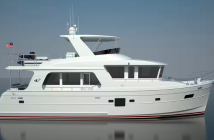
North Pacific Building 590 Pilothouse Flagship
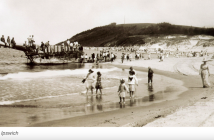
More Remains Revealed of Historic Shipwreck
Comments are closed.
- Create account

Yachting 1923

Yachting 1923 - Navy Pattern Casual Shirt 18 K 5058
Regular price €79,95

Yachting 1923 - Blue with Pattern Casual Shirt 18 K 5062

Yachting 1923 - White with small Pattern Casual Shirt 18 K 5063

Yachting 1923 - White with Red Dot Pattern Casual Shirt 18 K 5059
- choosing a selection results in a full page refresh
- Opens in a new window.
- Opens external website in a new window.
We will keep fighting for all libraries - stand with us!
Internet Archive Audio

- This Just In
- Grateful Dead
- Old Time Radio
- 78 RPMs and Cylinder Recordings
- Audio Books & Poetry
- Computers, Technology and Science
- Music, Arts & Culture
- News & Public Affairs
- Spirituality & Religion
- Radio News Archive

- Flickr Commons
- Occupy Wall Street Flickr
- NASA Images
- Solar System Collection
- Ames Research Center

- All Software
- Old School Emulation
- MS-DOS Games
- Historical Software
- Classic PC Games
- Software Library
- Kodi Archive and Support File
- Vintage Software
- CD-ROM Software
- CD-ROM Software Library
- Software Sites
- Tucows Software Library
- Shareware CD-ROMs
- Software Capsules Compilation
- CD-ROM Images
- ZX Spectrum
- DOOM Level CD

- Smithsonian Libraries
- FEDLINK (US)
- Lincoln Collection
- American Libraries
- Canadian Libraries
- Universal Library
- Project Gutenberg
- Children's Library
- Biodiversity Heritage Library
- Books by Language
- Additional Collections

- Prelinger Archives
- Democracy Now!
- Occupy Wall Street
- TV NSA Clip Library
- Animation & Cartoons
- Arts & Music
- Computers & Technology
- Cultural & Academic Films
- Ephemeral Films
- Sports Videos
- Videogame Videos
- Youth Media
Search the history of over 866 billion web pages on the Internet.
Mobile Apps
- Wayback Machine (iOS)
- Wayback Machine (Android)

Browser Extensions
Archive-it subscription.
- Explore the Collections
- Build Collections
Save Page Now
Capture a web page as it appears now for use as a trusted citation in the future.
Please enter a valid web address
- Donate Donate icon An illustration of a heart shape
Yachting 1923-12: Vol 34 Iss 6
Bookreader item preview, share or embed this item, flag this item for.
- Graphic Violence
- Explicit Sexual Content
- Hate Speech
- Misinformation/Disinformation
- Marketing/Phishing/Advertising
- Misleading/Inaccurate/Missing Metadata
plus-circle Add Review comment Reviews
Download options, in collections.
Uploaded by MicrofilmIssueGenerator on October 1, 2021
SIMILAR ITEMS (based on metadata)
15% korting vanaf 2 artikelen
- Wat is mijn maat?

- Zoeken naar:
Nieuwsbrief ontvangen?
Schrijf u in en ontvang het laatste nieuws het eerst.
Geen producten in de winkelwagen.
Terug naar winkel
- Winkelwagen
- Normale pasvorm
- Normale Pasvorm
- Truien, Vesten & Jacks
- Fysieke winkel
- Retourneren
- Maatschema’s
Resultaat 1–12 van de 300 resultaten wordt getoond

Overhemd Easy line Button Down VAS-5066

Overhemd Easy line Button Down VAS-5059

Overhemd Easy line Button Under 18-10107

Overhemd Easy line Button Down VAS-5063

Overhemd Easy line Button Down VAS-5062

Overhemd Easy line Button Down VAS-5061

Overhemd Easy line Button Down VAS-5060

Overhemd Easy line Button Down VAS-5033(1)

Overhemd Easy Line Button Down 19-10106 SS Korte mouw

Overhemd Easy Line Button Down 19-10105 SS Korte mouw

Overhemd Easy Line Button Down 19-10104 SS Korte mouw

Overhemd Easy Line Button Down 19-10103 SS Korte mouw
Gebruikersnaam of e-mailadres *
Wachtwoord *
Onthouden Inloggen
Wachtwoord vergeten?
Yachting Monthly
- Digital edition

An online archive of sailing articles and extra content from Yachting Monthly magazine

Survey completed
- July 13, 2020
The information you have provided is very valuable to us and will help us shape Yachting Monthly in 2021 and beyond. We are enormously grateful for your time, and please…

A sailing confession: Sink or swim
- May 16, 2020
Sink or swim - a confession by Ron Stoddart

Sailing by…or not – The Shipping Forecast
- November 10, 2014
This year marks the 90th anniversary of the Shipping Forecast. Sailor Carolyn Brown reads it out. Here she reveals why the radio studio can be an area of high pressure

Yachting Monthly winter laying-up checklist
- September 15, 2014
Whether your boat is coming ashore for winter or staying afloat, here is a useful checklist compiled by Yachting Monthly's experts to help you remember everything

Where should I put my anchor light?
- July 24, 2014
Hurricane lamp on the boom, or electric beacon at the masthead? Duncan Kent gives advice on the best place to hang your anchor light

Action cameras – Yachting Monthly video review
- May 23, 2014
They're perfect for capturing videos and still photos on the water – but which action camera is best for you...?

Marine engine soundproofing
- April 16, 2014
Yachting Monthly guidelines for installing marine engine soundproofing

How useful is iPad navigation when sailing a yacht?
- March 5, 2014
Six important points to consider before ditching your chartplotter

How to avoid chafe on swinging moorings
- February 5, 2014
Vyv Cox explains a simple error that causes chafe on swinging moorings and catches out many crews, including experts

Rope problems and solutions
Tom Cunliffe shares his expertise on the topic of rope problems and solutions
The True Story Behind '1923’s Ghost Ship
The Zebrina ran ashore on the coast of France in 1917. Up to this day, no one knows what happened to its crew.
Editor's note: The below contains spoilers for Episode 5 of 1923. The fifth episode of Paramount+’s 1923 , "Ghost of Zebrina," is titled after one of the most fantastical things to appear in the Dutton-verse so far. During their seemingly endless journey back to the States, Spencer ( Brandon Sklenar ) and Alexandra ( Julia Schlaepfer ) are nearly killed when their ship almost collides with an empty vessel stranded in the middle of the ocean.
Thankfully, the two are saved by the expertise of captain Lucca ( Peter Stormare ), who then proceeds to tell them all about ghost ships and the danger they pose to sailors. One of the stories that he shares is that of the Zebrina, a ship that was found completely abandoned on the coast of France, its crew having disappeared in mysterious circumstances. It’s one of those stories that sound too good (and spooky!) to be true, but true it is. The Zebrina was a real ghost ship, and, so far, no one knows for sure what happened to its crew.
RELATED: '1923's Timothy Dalton Is 'Yellowstone's Most Terrifying Villain So Far
Spencer and Alexandra Learn About the Zebrina During Their Trip to the Suez
Spencer Dutton first crosses paths with Lucca while trying, and repeatedly failing, to find a way to return to the States upon hearing of his brother’s death and the harm that came over his uncle Jacob ( Harrison Ford ). Wishing to be near his family, he convinces Alexandra to return home with him and starts looking for a ship that can get them back. Alas, there are no ships sailing directly from Mombasa or anywhere else in Africa to the US, and the next vessel bound for London won’t leave for another month. With no time to waste, Spencer starts looking for alternatives. The best one he finds is paying to work on a tugboat headed to the Suez Canal. From there, he can get a ship to any European port, and then to the States.
The tugboat that Spencer and Alexandra eventually board belongs to captain Lucca, an elderly, ailing man that is constantly coughing up blood. However, his poor health hasn’t yet taken a toll on his abilities as a seamaster, which come in handy when the boat is nearly crushed by an enormous ship sailing aimlessly near the Suez Canal. Lucca is quick to steer the tugboat away, avoiding a collision.
In the process, he also finds the time and the energy to give Spencer a brief lesson on ghost ships. He explains to him that the vessel that nearly collided with theirs was abandoned after its boilers blew and that the canal’s current keeps it from running aground. Later that day, he tells Spencer and Alexandra the story of another ghost ship, a mysterious vessel known as the Zebrina.
According to Lucca’s story, the Zebrina was a British cargo ship that ran aground in France on its way to join the war effort. Lucca, who was part of a hospital ship’s crew at the time, says he spent weeks running away from it. It was as if the abandoned ship was chasing them. He then proceeds to speak of even stranger occurrences off the coast of Indonesia. But even though the stories of fishing boats surrounded by seagulls eating away at the dead crew members are indeed horrifying, it's the Zebrina that truly sticks with us — especially given what happens to Spencer and Alex later in the episode. After all, it's named "Ghost of Zebrina."
What Is the True Story of the Ghost Ship Zebrina?
The Zebrina was a real ghost ship that roamed the Atlantic sometime in the first half of the 20th century, more specifically in the final years of World War I. As captain Lucca says, the ship ran aground in 1917, while transporting coal from England to the town of Saint-Brieuc, in northwestern France. But what exactly is known about the Zebrina and its fate?
Well, for starters, the Zebrina wasn’t originally intended for travels by sea . Built in 1873, the ship was a trade vessel meant to navigate the River Plate, in South America. However, in 1881, the ship was taken to Britain and placed in the European coasting trade. According to boating expert John Leather, the ship gained a reputation as a lucky vessel. Sadly, that reputation didn’t stop it from meeting a tragic fate.
Now, what exactly that fate was is kind of anyone’s guess. What is known is that the Zebrina sailed from Falsmouth to Saint-Brieuc in October, 1917 , carrying a shipment of coal. Alas, it never reached its intended destination. The ship was found only two days after it set sail on the shore of Rozel, south of the French city of Cherbourg. Apart from some disarrangement to the rigging, Leather says, there was no damage done to it. Still, its crew was completely gone. This led many to conclude that the ship had been attacked by a U-boat. The Zebrina’s crew are believed to have been taken prisoner.
But even with a theory as plausible as this one right at hand, there is still much speculation about what happened to the crew of the Zebrina. Those devoted to historic mysteries claim that it was unusual for U-boats to take prisoners from other ships, and that the Zebrina escaped completely unscathed from the alleged attack. Furthermore, it seems that there were no records of the attack on the Zebrina found after the war. This led some to believe that the U-boat responsible for the attack on the vessel sank sometime after the strike. Others claim that the ship’s small crew was thrown off the boat by a squall .
What is known, however, is the fate of the Zebrina after it ran ashore. According to Leather , the ship was salvaged, refitted, and turned into a coal hulk from 1928 to 1930. She was then turned back into a schooner, and worked the coal routes in the coast of England up until it caught fire somewhere between Blyth and Truro. Deemed unseaworthy after the incident, the ship’s hull spent many years exposed in Velder Creek until it was set on fire, in 1953 .
The Zebrina Isn’t the Only Real Ship to Appear in ‘1923’ Episode 5
Yet another real ship featured in “Ghost of Zebrina” is the RMS Mauretania, which gets its own cameo as the ship Spencer and Alexandra board to try and send a message to the States. Launched in 1906, the Mauretania was a transatlantic vessel that was considered the fastest in the world up until 1929. It was the sister ship of the Lusitania, famously sunk by the Germans during World War I. According to the Encyclopedia Britannica , the Mauritania served as a transport and hospital ship during the war, and made 269 double crossings of the Atlantic as a commercial liner. The end of its career came in 1934. The following year, the ship was completely dismantled.
1923 premieres new episodes every Sunday on Paramount+.
- Bahasa Indonesia
- Slovenščina
- Science & Tech
- Russian Kitchen
Before and after: How Moscow looked in the 19th century and today (PHOTOS)

1. The Kremlin as seen from across the Moskva River, 1866
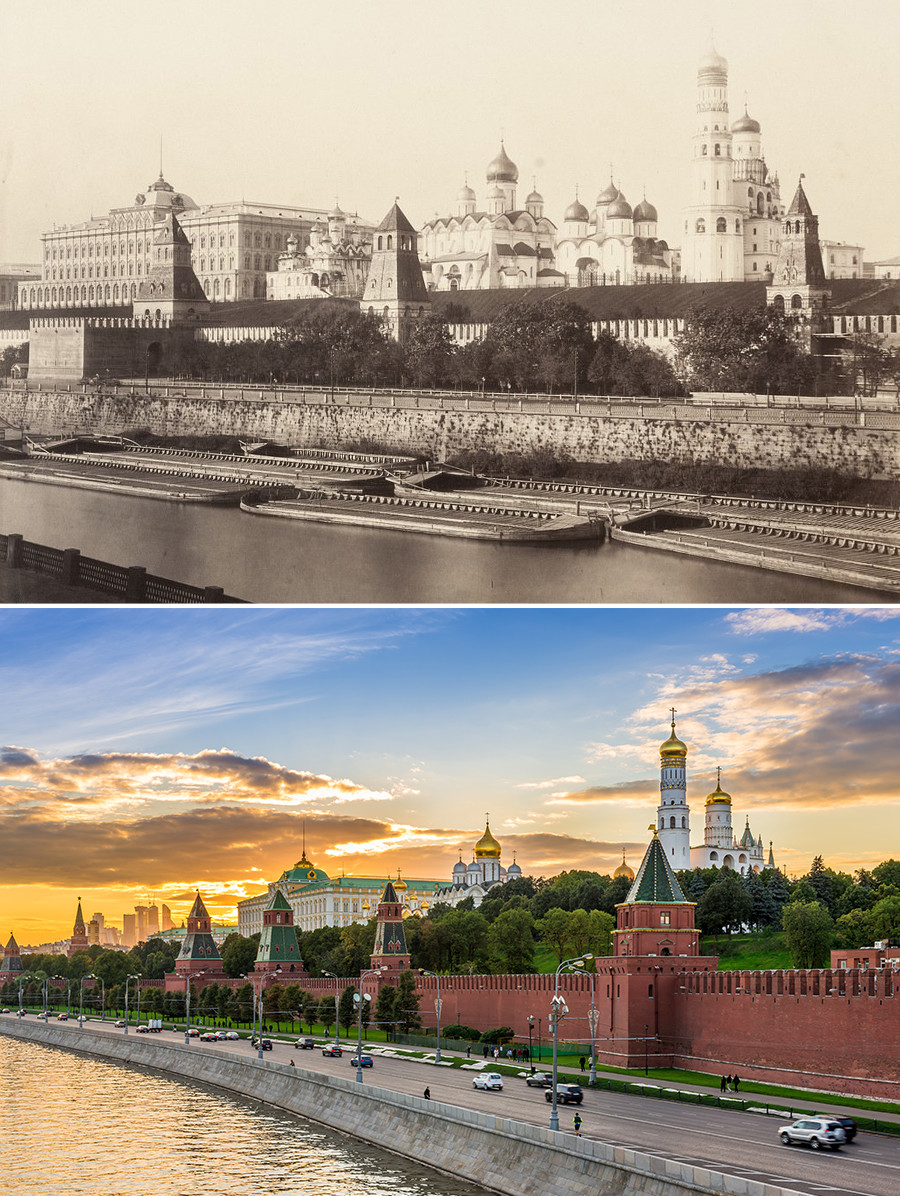
This image was a gift album to Maria Feodorovna (Dagmar of Denmark), wife of Alexander III and mother of Nicholas II.
Though the Kremlin's buildings, especially Orthodox churches, suffered much at the hands of the Bolsheviks, this area has changed little since that time.
2. Voskresenskaya Square and Chapel of Iverskaya Icon of The Mother of God, 1900s
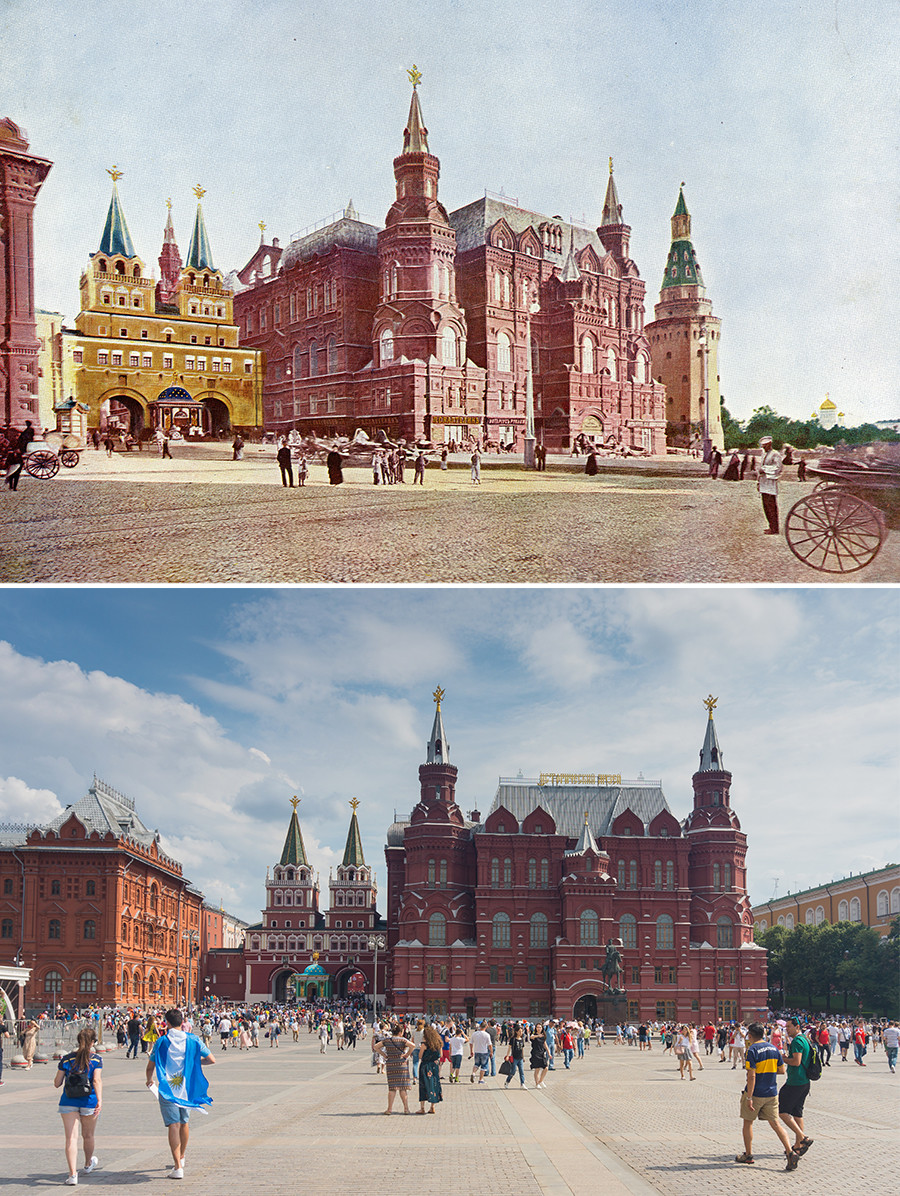
This place is now called the Square of the Revolution, and the red building is the State Historical Museum.
This is Moscow's zero mile marker. Throw a coin in for good luck. In 1995, an equestrian statue to World War II hero Marshal Zhukov was erected here.
3. Smolensky Market, 1906
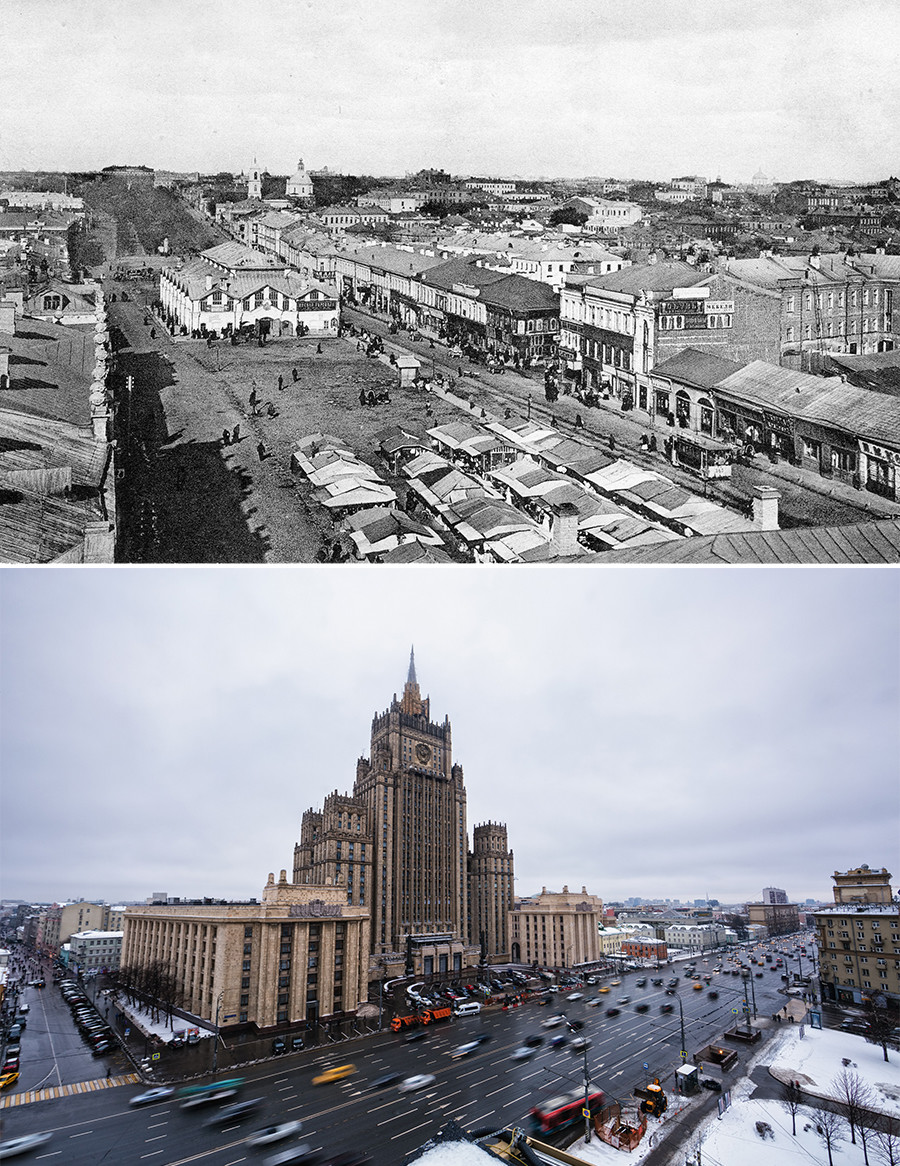
This was a spontaneous market on the crossroads of Arbat Street and Old Smolensky Tract, which led to the city of Smolensk.
Now, a Stalin-era skyscraper (Ministry of Foreign Affairs) stands here, as well as the wide avenue of the Garden Ring. Commerce is still conducted here, and there are many business offices nearby.
4. Krymsky Bridge , Neskuchny Garden and Zachatyevsky Monastery , 1886
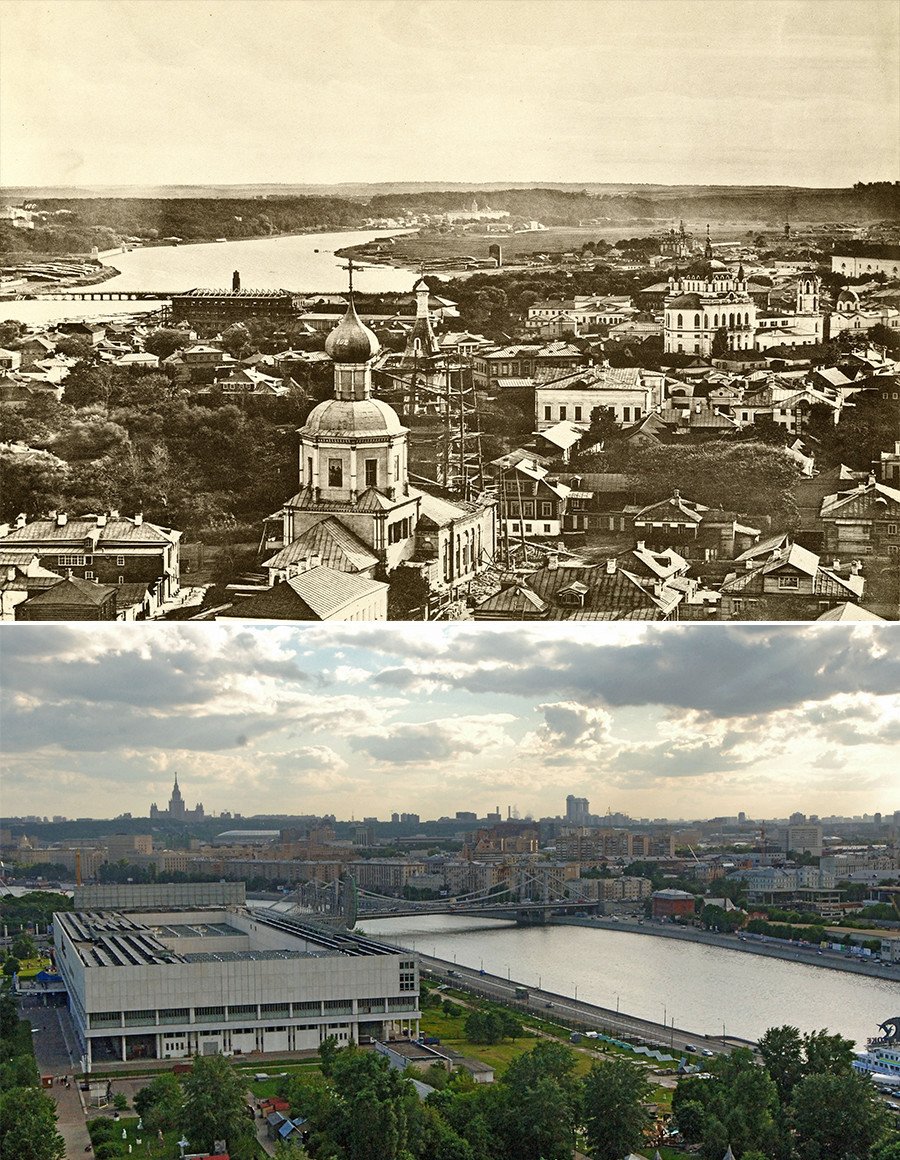
This photo was made 50 years ago, and today’s popular Gorky Park was opened on the forested side of the Moskva River. Also, notice that Krymsky Bridge is missing.
Zachatyevsky Monastery is now scrunched between office and residential buildings.
On the other side of the river is the New Tretyakov Gallery.
5. House of Romanov boyars
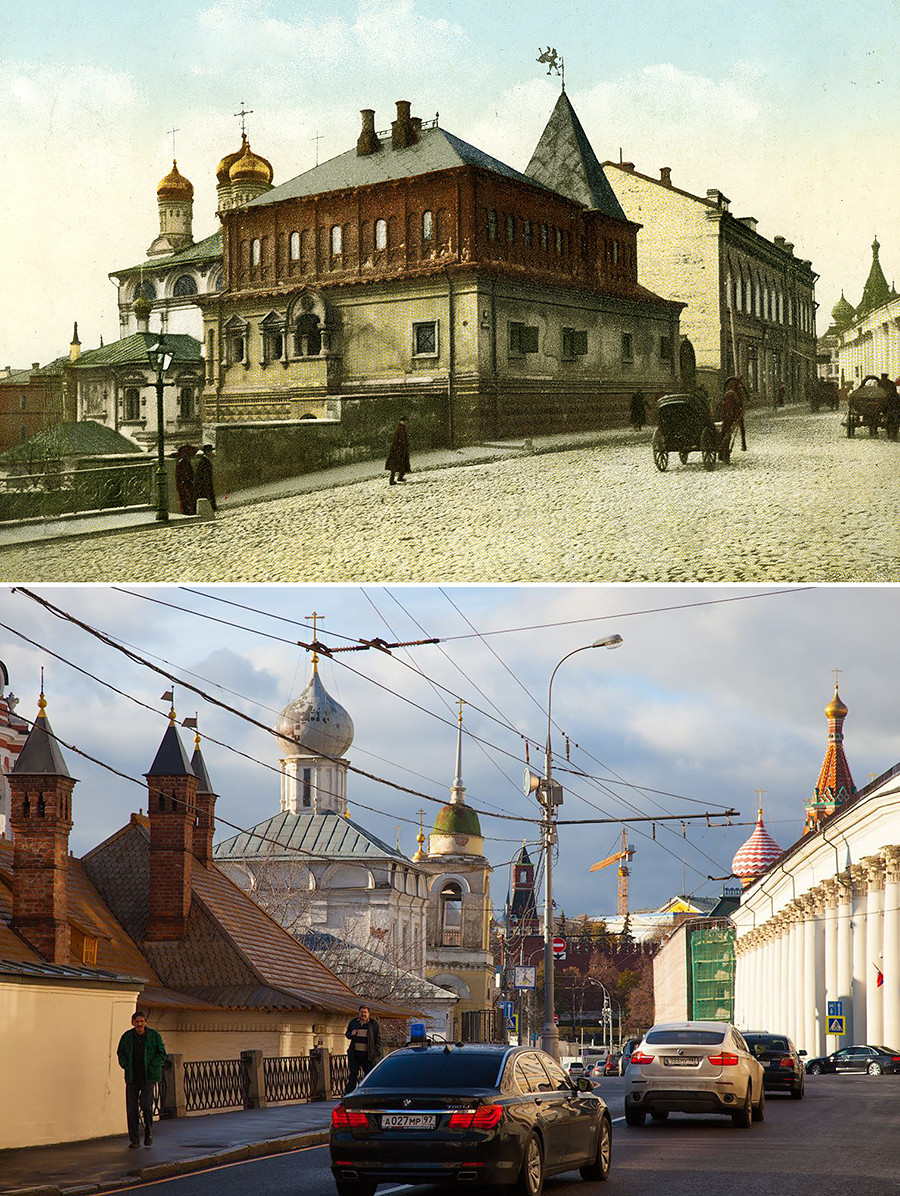
In this medieval house on Varvarka Street, close to the Kremlin, the first tsar of the Romanov dynasty - Mikhail - was born in 1596.
Today, this ‘palace’ still stands, surrounded by medieval churches and the Old English Court that was built in the early 16th century. The street and the museums are next to the new Zaryadye Park.
6. Lubyanka Square, 1890s
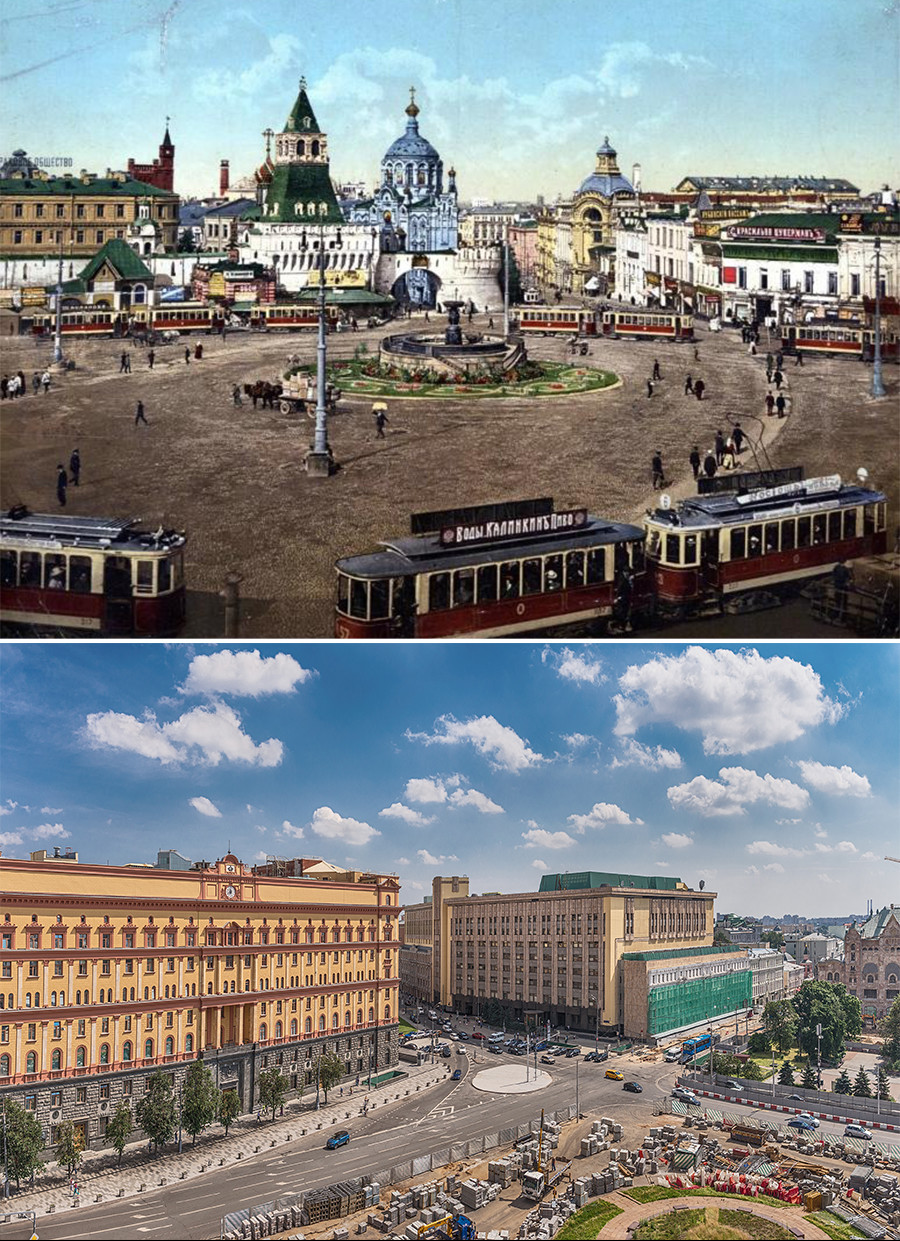
The medieval gates of Kitai-Gorod stood here long before Muscovites saw the appearance of the KGB building, which of course is a symbol of Stalinist repression and torture. Different stores occupied this area, and in the center of the square was a beautiful fountain made by a sculptor with Italian roots, Ivan Vitali.
In Soviet times, the fountain was moved to Neskuchny Garden, and a monument to the bloody KGB leader, Felix Dzerzhinsky, was erected instead. It was demolished in 1991, however, and now the spot is vacant.
7. St. Basil’s Cathedral, 1905
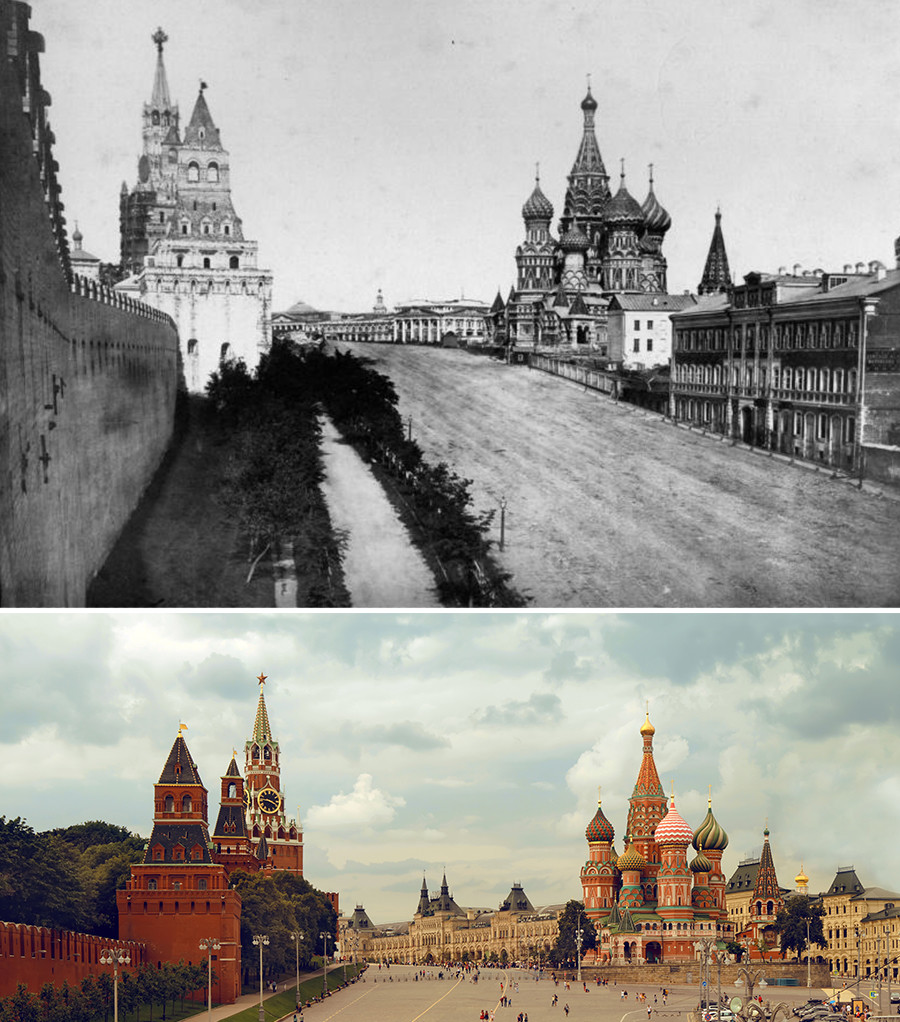
Erected by Ivan the Terrible in the mid-16th century in honor of the conquest of Kazan, it’s now one of the most recognizable symbols of Russia, not to mention Red Square’s pearl.
While the country’s main cathedral, Christ the Savior, was demolished by the Bolsheviks, this cathedral was spared. The street leading to Red Square is called Vasilevsky Descent and is now covered with cobblestones. Large outdoor concerts are held here from to time.
8. Donskoy Monastery, 1882
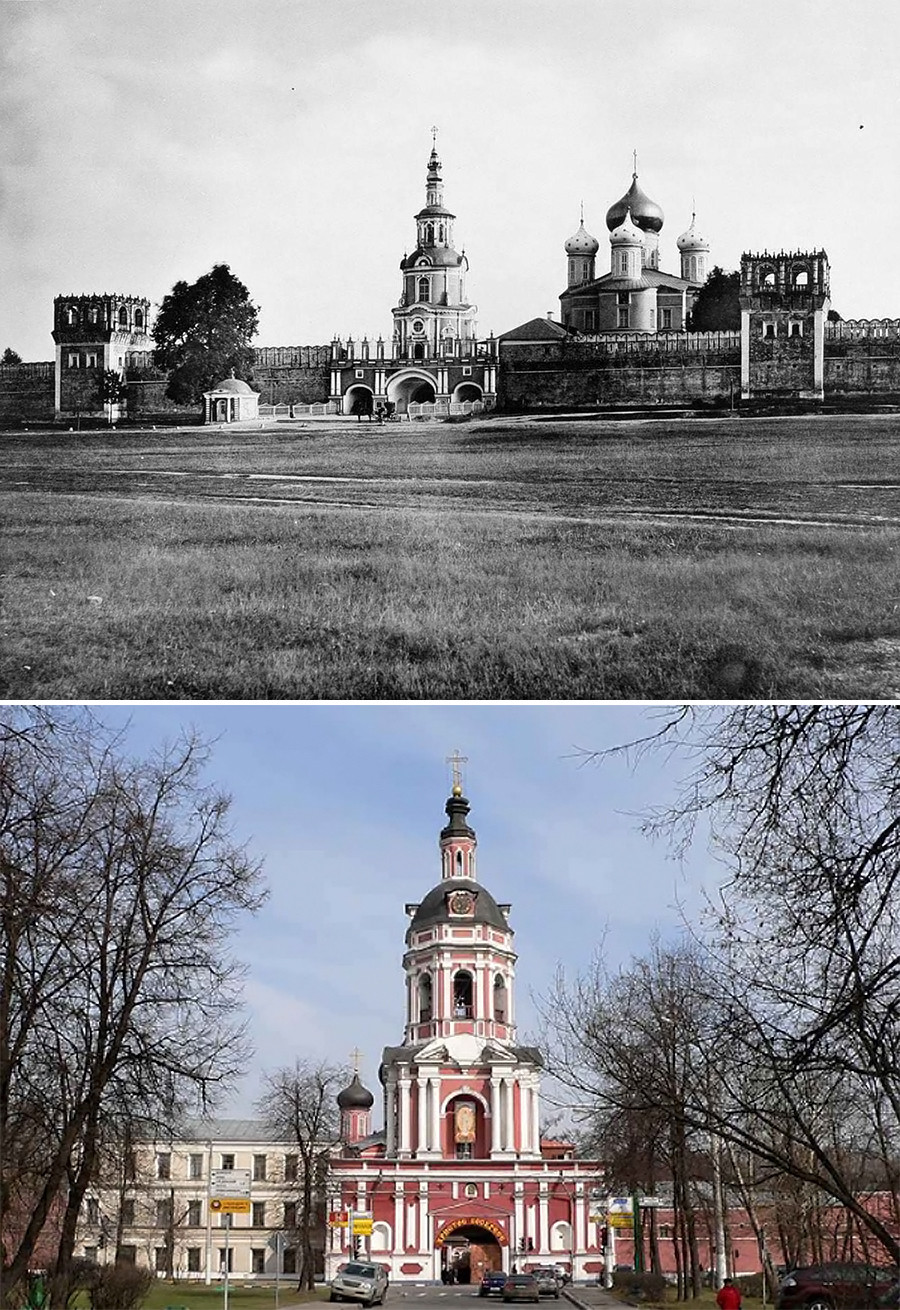
It was seen as a miracle when in the 16th century the Crimean khan with his formidable army retreated from the walls of Moscow. Donskoy Monastery was erected on the battlefield south of Moscow’s city limits at that time, but which is an area that’s now part of the city center.
In Soviet times, anti-religious art exhibitions were displayed instead of church services, which started again here only after Perestroika .
9. Pashkov House, 1896
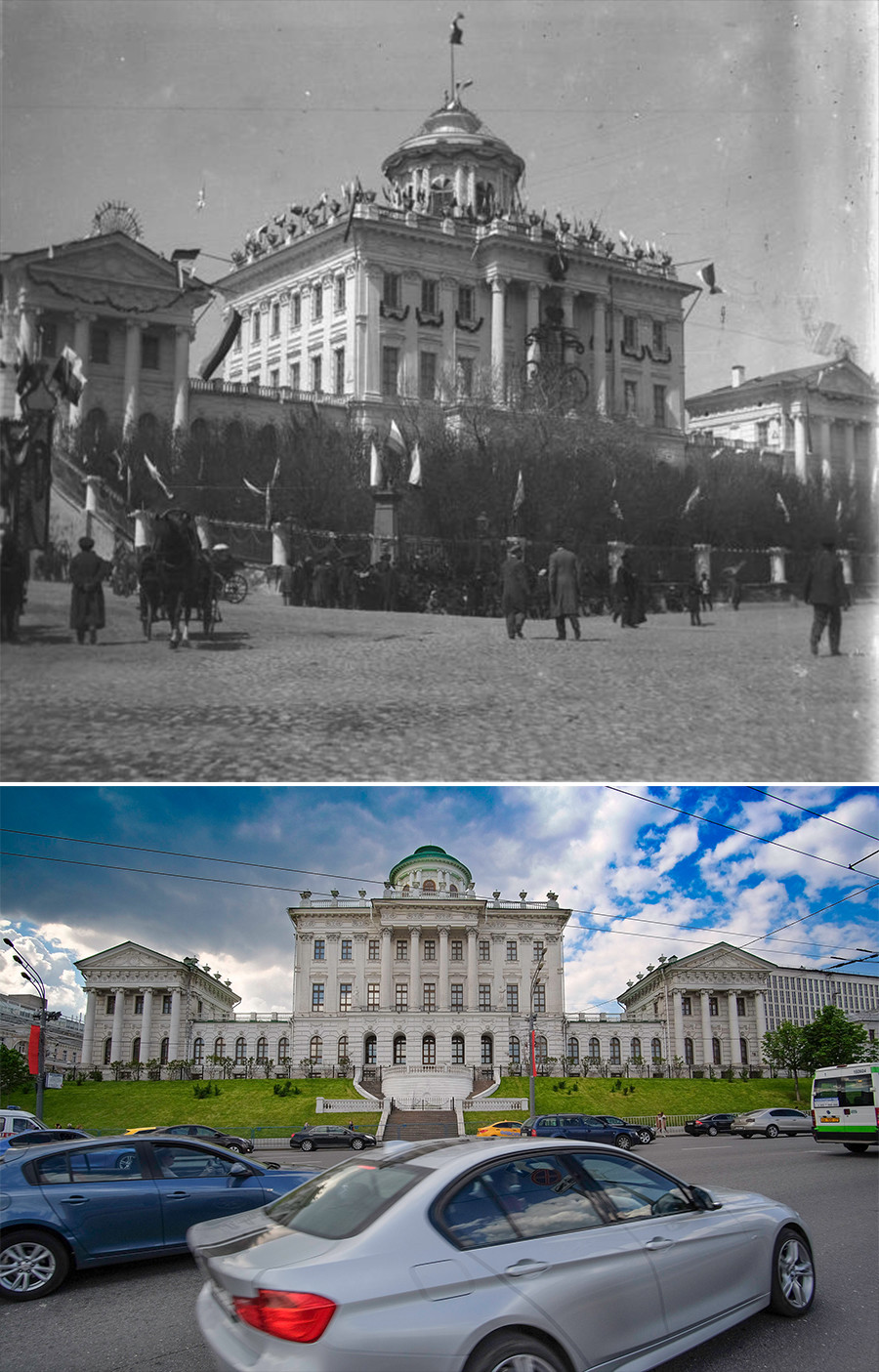
This photo was made during the coronation of Russia’s last tsar, Nicholas II. There was a big feast for the imperial court, and the city center was sumptuously decorated.
This is one of Moscow’s most gorgeous buildings, and it was the first site of the Russian State Library, the largest public library in the country. Rare manuscripts, sheet music and maps are still stored here.
10. Kremlin seen from southeast , 1880s
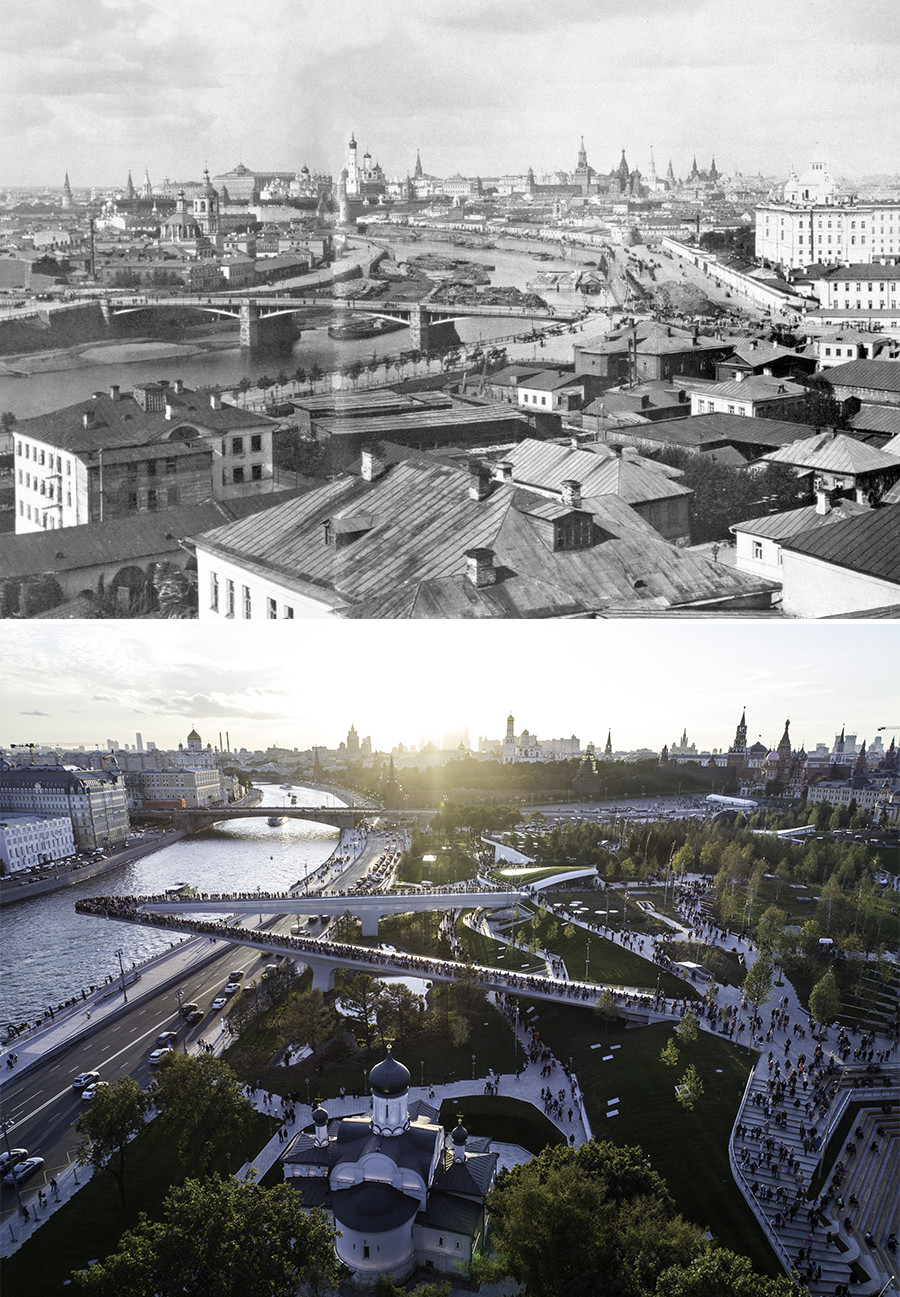
In the 20th century, the area around the Kremlin was built up. Inside, the communists built a new State Kremlin Palace, which is the only modern structure in the Kremlin, built for Party meetings.
From the 1960s and until 2006, in front of Red Square stood the massive Hotel Rossiya, which was demolished that year. For more than a decade afterwards , the area was a fenced-off construction site. In 2017, however, Zaryadye Park opened with its stunning floating bridge over the Moskva River.
From July 4 to August 13, 2018, the exhibition, “Moscow in Photographs from the 1860s to the early 1900s,” is on display at the State Russian Museum in St. Petersburg as part of the series, “Traveling around the Russian Empire.”
If using any of Russia Beyond's content, partly or in full, always provide an active hyperlink to the original material.
to our newsletter!
Get the week's best stories straight to your inbox
- How Moscow looked 50 years ago (PHOTOS)
- How the first Soviet beauty contest was staged (PHOTOS)
- Moscow's Kremlin in the 18th and 19th centuries (PHOTOS)
- How bears really walked the streets in Russia
- 20 Moscow metro stations ranging from beautiful to absolutely breathtaking
This website uses cookies. Click here to find out more.
2018 Primetime Emmy & James Beard Award Winner
Reviving classic Russian cuisine
Oct 19 2018.
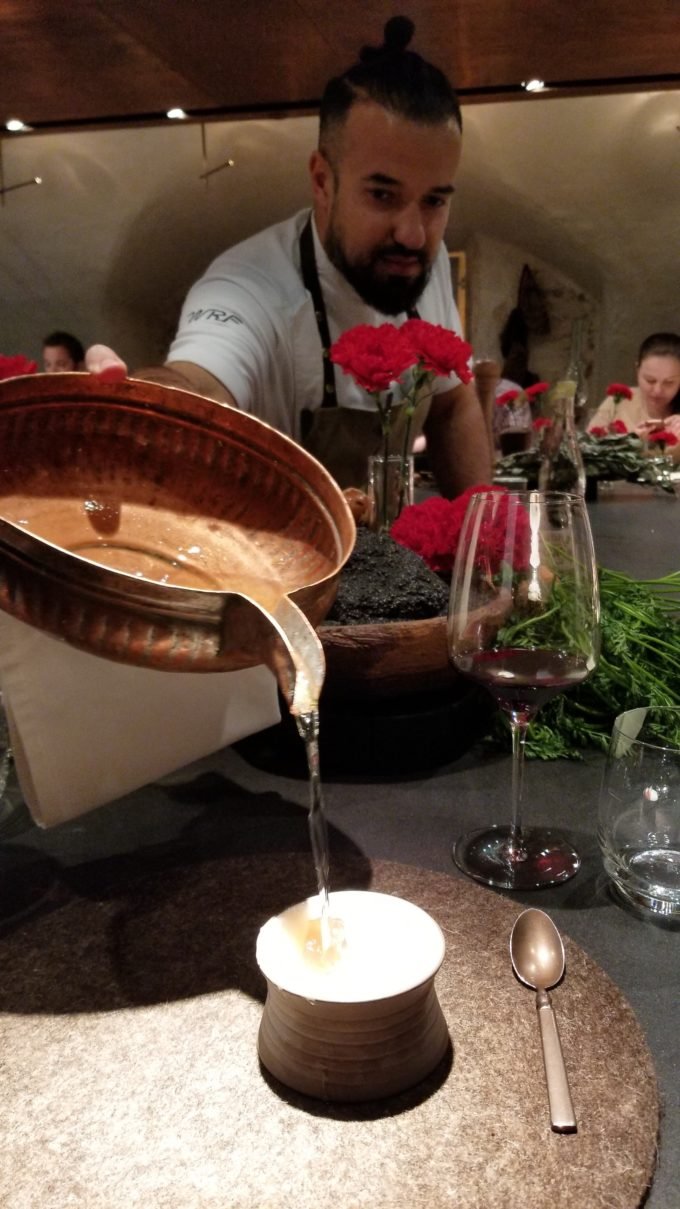
Roads & Kingdoms talks to Russian chef Vladimir Mukhin of Moscow’s super-restaurant, White Rabbit.
Still in his mid-30’s, Vladimir Mukhin is already one of Russia’s best known chefs and the leading culinary light of the White Rabbit Group, which has 16 restaurants around the country. The most well-known of these, Moscow’s White Rabbit , was named one of the 50 best restaurants in the world last year. Roads & Kingdoms’ Nathan Thornburgh talked to Mukhin in Moscow about being a fifth-generation chef, reviving classic Russian cuisine, and finding good product in the age of embargoes.
Nathan Thornburgh: Tell me about White Rabbit, what is the food? What are you trying to accomplish there?
Vladimir Mukhin: The White Rabbit is a big restaurant. We’re trying to revive Russian cuisine. I’m a fifth-generation chef, so I’m passionate about the food we create. During the Soviet Union period, we killed Russian food. Classic Russian recipes became too simplified. For example, usually you drink tea, but if you want to be, just to be creative, want to make the tea with milk, you can’t. It would be like stealing milk from the government. People went to jail.
When I was growing up, I remember my grandfather coming to the kitchen and crying because he couldn’t experiment with his food.
Thornburgh: Wow. I remember this famous photo session with Che Guevara which came up with some of his best pictures, maybe two incredible iconic portraits came from an entire roll of film, and the photographer went to him and showed him this roll of film and Che said, What the hell are you doing? You wasted all of these images. You took 30 pictures to get one? That’s the government’s film. It’s a similar mentality. So you’re telling the story of a kind of cuisine that was lost on the Soviet history and now you’re playing with this idea of finding it again. What does your process look like? Do you get as many grandmothers as you can round up and just kind of shake recipes out of them? How were you doing this?
Mukhin: I just try to work with as many local farmers and producers as I can, so we can use as many Russian ingredients as we can.
Thornburgh: So this is a close relationship.
Mukhin: Yes. I traveled throughout Russia—not just the big cities, but also the villages to talk with older people.
Thornburgh: You know I think people don’t understand the vastness of Russia, and how big it’s collection of cultures and languages and cuisines is. What parts of the country influences your food?
Mukhin: I’m inspired by the whole country. It’s a big territory, and sometimes it feels like it’s too big. I try and use different techniques and ingredients from all over the country, which I think makes my menus distinct.
We have an a la carte menu with about 50 dishes of classical Russian food. Everything looks modern because I’m a young chef. But if you close your eyes and try these dishes, you’ll taste 100% classic Russian flavors.
I want to highlight all aspects of Russian cuisine. Before the Olympic Games in Sochi, we opened a restaurant there, not just to make money, but to expose people visiting for the Olympics to Russian food. That’s why we opened The Red Fox restaurant. It’s all about Russian ingredients.
Thornburgh: Sochi, at least when I’ve been there, is like a Miami Beach. It’s like a place to get pizza and sushi, and go to the nightclubs.
Mukhin: You been?
Thornburgh: Yeah.
Mukhin: It’s crazy.
Thornburgh: It’s a little crazy, but it’s interesting to bring in Red Fox and sort of say okay, because people are coming out, let’s bring Russia to Sochi.
Mukhin: It was incredible. We had thousands of visitors at the restaurant.
Thornburgh: So you really looked internally for inspiration. Did working outside of Russia motivate you to focus on Russian cuisine?
Mukhin: Yes. I spent time working in Avignon, France. I worked with Christian Etienne, and he would make a special Russian meal once a year. It was crazy.

Thornburgh: How was the food?
Mukhin: It was shit. I told him that I would cook real Russian food for him, and I did. I cooked borscht, blinis, and other classics. He liked it and said that once a year we should use my recipes, but with his influence. I agreed, and we went on to make amazing food. Eventually, I wanted to come back to my motherland. So I left and I started working on making White Rabbit a reality.
Thornburgh: When people go to White Rabbit, what are they going to find?
Mukhin: Someone once told me that there is a new Russian cuisine and an old Russian cuisine. I think Russian cuisine is going through an evolution. So I hope people will come and see evolution at White Rabbit.
Thornburgh: Great. Always good to end on an invite. Thank you.
Mukhin: Thank you so much.
R&K Insider
Join our newsletter to get exclusives on where our correspondents travel, what they eat, where they stay. Free to sign up.
21 Things to Know Before You Go to Moscow
Featured city guides.

IMAGES
VIDEO
COMMENTS
Welkom bij Yachting 1923. Wij presenteren hier onze welbekende overhemden van Yachting 1923 en Vassalli evenals onze polo´s, truien en vesten, alle van hoge kwaliteit en subliem van pasvorm. _____ 15% korting vanaf 2 artikelen Lees meer Webshop
sim_yachting_1923-01_33_1 Pub_type Magazines Scanner microfilm04.cebu.archive.org Scanningcenter cebu Sim_pubid 940 Software_version nextStar 4.5.0.20626 Source IA1631911-01 microfilm . Show More. plus-circle Add Review. comment. Reviews There are no reviews yet. Be the first one to ...
Yachting 1923-01: Volume 33, Issue 1.Digitized from IA1631911-01.Previous issue: sim_yachting_1922-12_32_6.Next issue: sim_yachting_1923-02_33_2. Skip to main content. We will keep fighting for all libraries - stand with us! A line drawing of the Internet Archive headquarters building façade. An illustration of a magnifying glass. ...
The New York Yacht Club, founded in 1844, ... In 1923, Charles L. Harding of Boston, commissioned the Herreshoff plant to build a 68-foot waterline racer. This new schooner from Bristol named WILDFIRE, was the first to be built for a jib-headed mainsail. She was a roomy boat and her success, is shown by her winning of the Astor Cup for schooners.
TAGS: cruising Top Story. During the afternoon of 20 March, 1923, following 'a good lunch' in the Royal Irish Yacht Club, Conor OBrien slipped the mooring of his yacht Saoirse (pronounced 'Seershah' and meaning 'freedom') and left Dun Laoghaire, County Dublin, on a voyage around the world. On leaving the yacht club he was asked when ...
The sailing trials were held on September 18, 2014 directly offshore of the beaches of Panama City, Florida. Ninety-one years earlier, the original Columbia was officially measured on October 27, 1923 just before her race with the Bluenose by Raymond J. Milgate, a marine surveyor of Halifax, N.S.
Yachting 1923, Ommen (gemeente). 130 likes. Yachting 1923 is een kledinglijn gespecialiseerd in stijlvolle mannen overhemden, sportief klassiek en op de Europese maatvoering geproduceerd. Yachting 1923
Yachting, 1923 COPYRIGHT INFORMATION ~ When using this image, the credit information should be in the following format: Image courtesy of the Museum. For more information, please contact us at [email protected]. San Diego Yacht Club 1011 Anchorage Lane, San Diego, CA 92106 (619) 221-8400 www.sdyc.org [email protected] [email protected]
Yachting, MotorBoating and The Rudder were among the most prominent magazines writing about boats and yachting in the twentieth and late nineteenth centuries. Article citations below refer to month, year and then page number. ... Yachting entries cover the years 1923-1958, with additional entries from 1907 and 1908. MotorBoating entries cover ...
"Yacht" is an English word derived from the Dutch word jaght meaning a hunt or to pursue, and is short for jaghtschip. The name was given to any of various relatively small ships for pleasure cruising and racing. ... Finally, on August 18, 1923, the members raised their burgee over the completed clubhouse. The 100 members elected George S ...
The Hodgdon Liberty Commuter Yacht, pictured above, is probably closest to the original commuters, with its long sheerline, low profile and pronounced reverse transom. Built in Maine, this 80-foot Hodgdon has the mahogany interior of the original commuters, but it also has some carbon-fiber parts, including the mast, boom and rudder stocks.
Yachting 1923 - Navy Pattern Casual Shirt 18 K 5058. €79,95. Yachting 1923 - Blue with Pattern Casual Shirt 18 K 5062. €79,95. Yachting 1923 - White with small Pattern Casual Shirt 18 K 5063. €79,95. Yachting 1923 - White with Red Dot Pattern Casual Shirt 18 K 5059. €79,95.
Yachting 1923-12: Volume 34, Issue 6.Digitized from IA1631911-01.Previous issue: sim_yachting_1923-11_34_5.Next issue: sim_yachting_1924-01_35_1. Skip to main content. Due to a planned power outage on Friday, 1/14, between 8am-1pm PST, some services may be impacted. A line drawing of the Internet Archive headquarters building façade. ...
Snel bekijken. 15% korting vanaf 2 artikelen. Overhemd Easy Line Button Down 19-10103 SS Korte mouw. € 69,95 incl. BTW.
An online archive of sailing articles and extra content from Yachting Monthly magazine. Survey completed. July 13, 2020 The information you have provided is very valuable to us and will help us shape Yachting Monthly in 2021 and beyond. We are enormously grateful for your time, and please…
100 Followers, 696 Following, 130 Posts - See Instagram photos and videos from (@yachting_1923)
The Zebrina Isn't the Only Real Ship to Appear in '1923' Episode 5 Yet another real ship featured in "Ghost of Zebrina" is the RMS Mauretania, which gets its own cameo as the ship ...
In the 20th century, the area around the Kremlin was built up. Inside, the communists built a new State Kremlin Palace, which is the only modern structure in the Kremlin, built for Party meetings ...
Oct192018. Roads & Kingdoms talks to Russian chef Vladimir Mukhin of Moscow's super-restaurant, White Rabbit. Still in his mid-30's, Vladimir Mukhin is already one of Russia's best known chefs and the leading culinary light of the White Rabbit Group, which has 16 restaurants around the country. The most well-known of these, Moscow's ...
This Mens Oxfords & Button Downs item is sold by OnlyLuxForMen. Ships from Poland. Listed on Feb 21, 2024
SUBSCRIBE and "Ring the bell" http://bit.ly/2y1dZNpChannel downloads: https://simtube.games/Social Media Links: Discord: https://discord.gg/XJbrgTg Face...
Here's an F2 onboard lap at the Autodrom Moscow in Moscow, Russia. This hotlap is driven in Assetto Corsa with Robert Shwartzman in the F2 2020 car, using th...